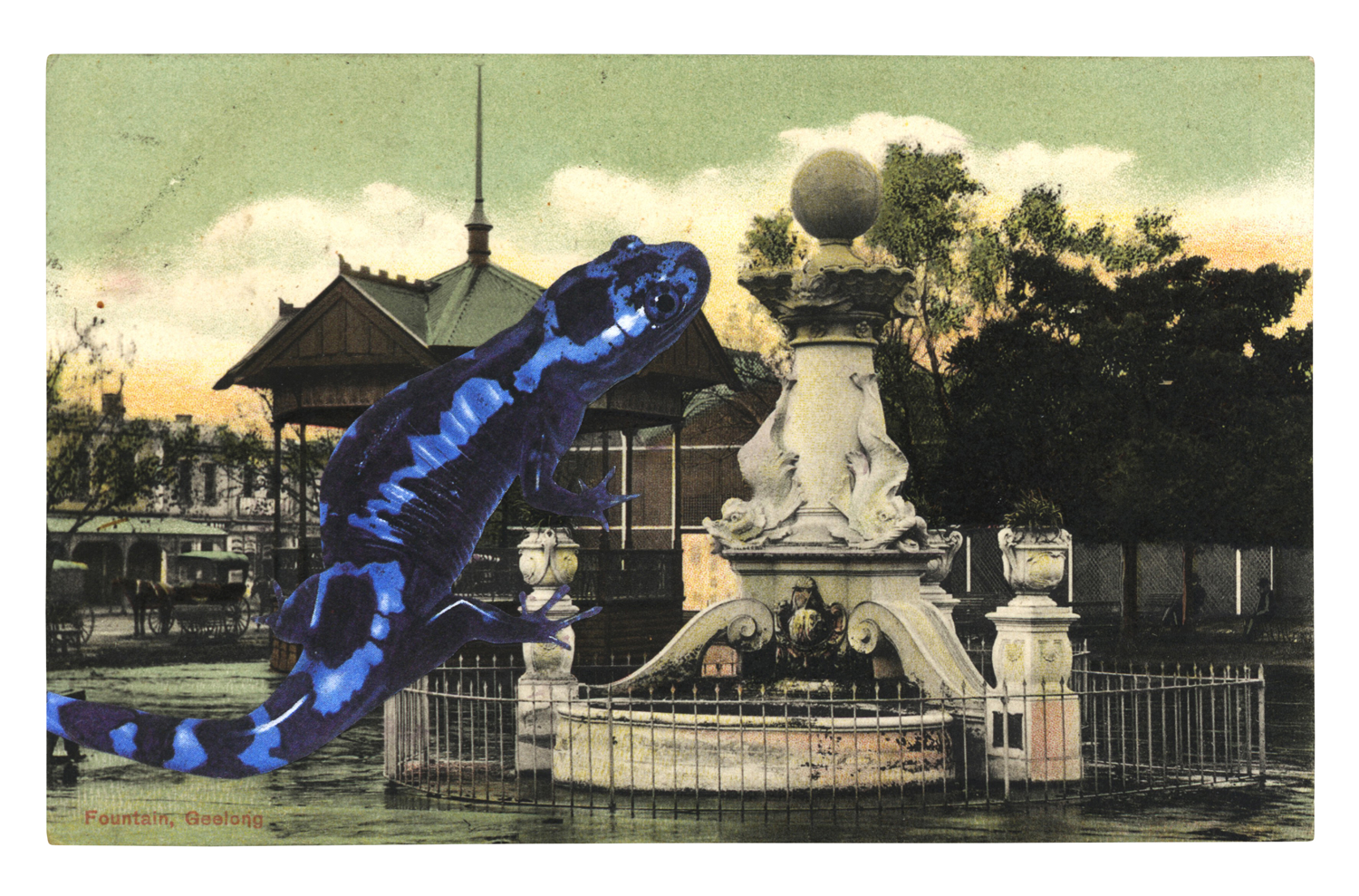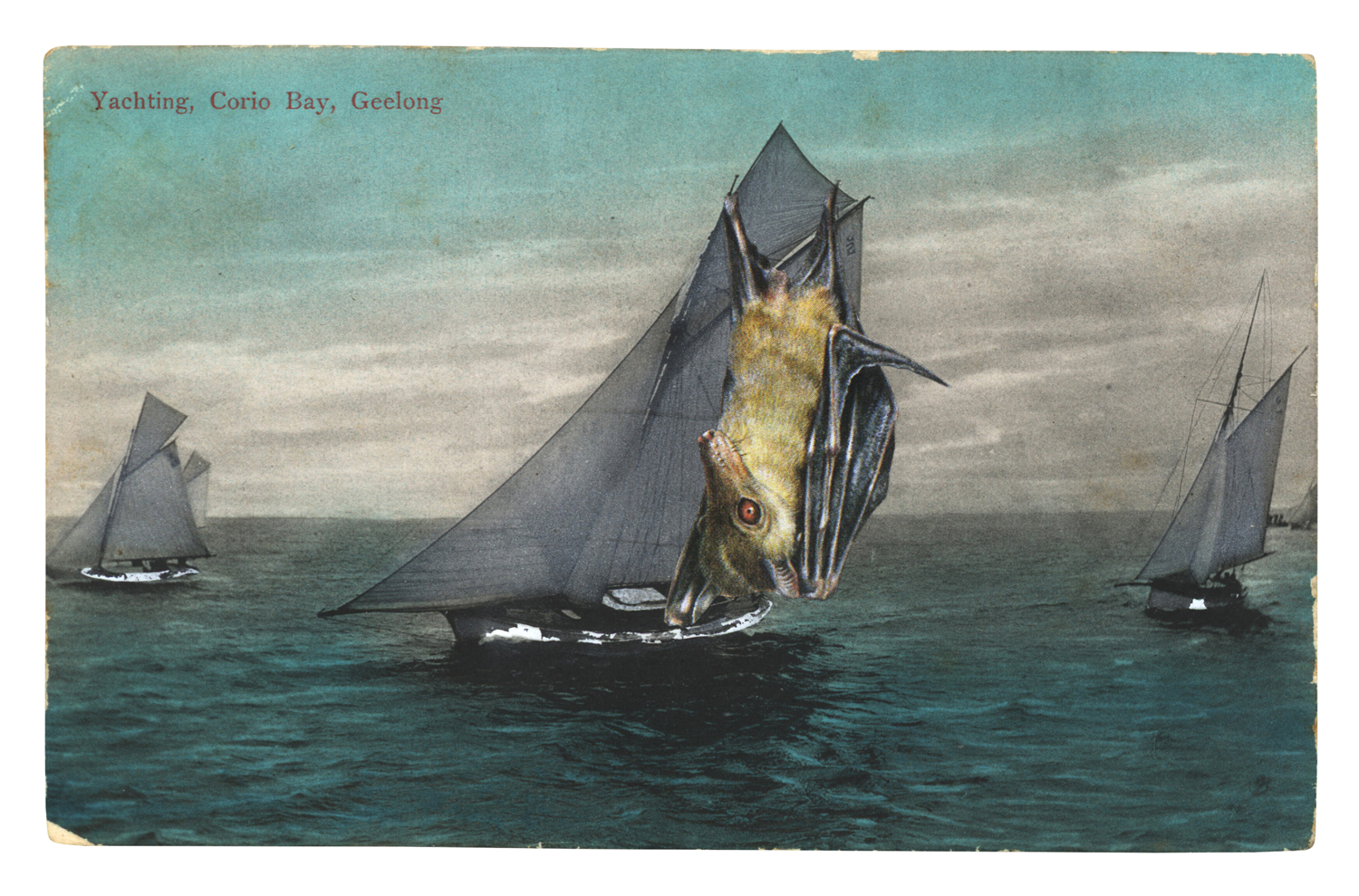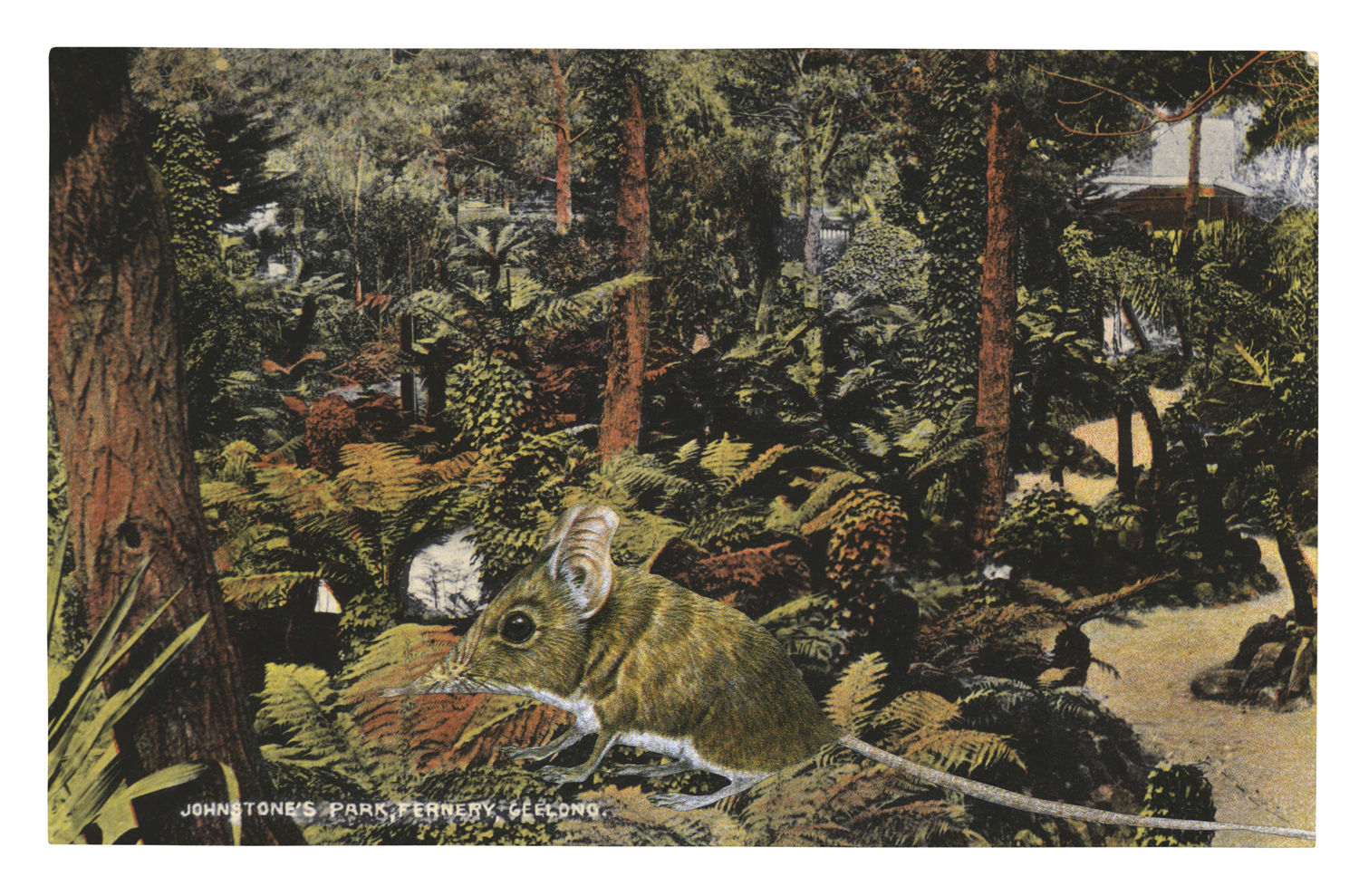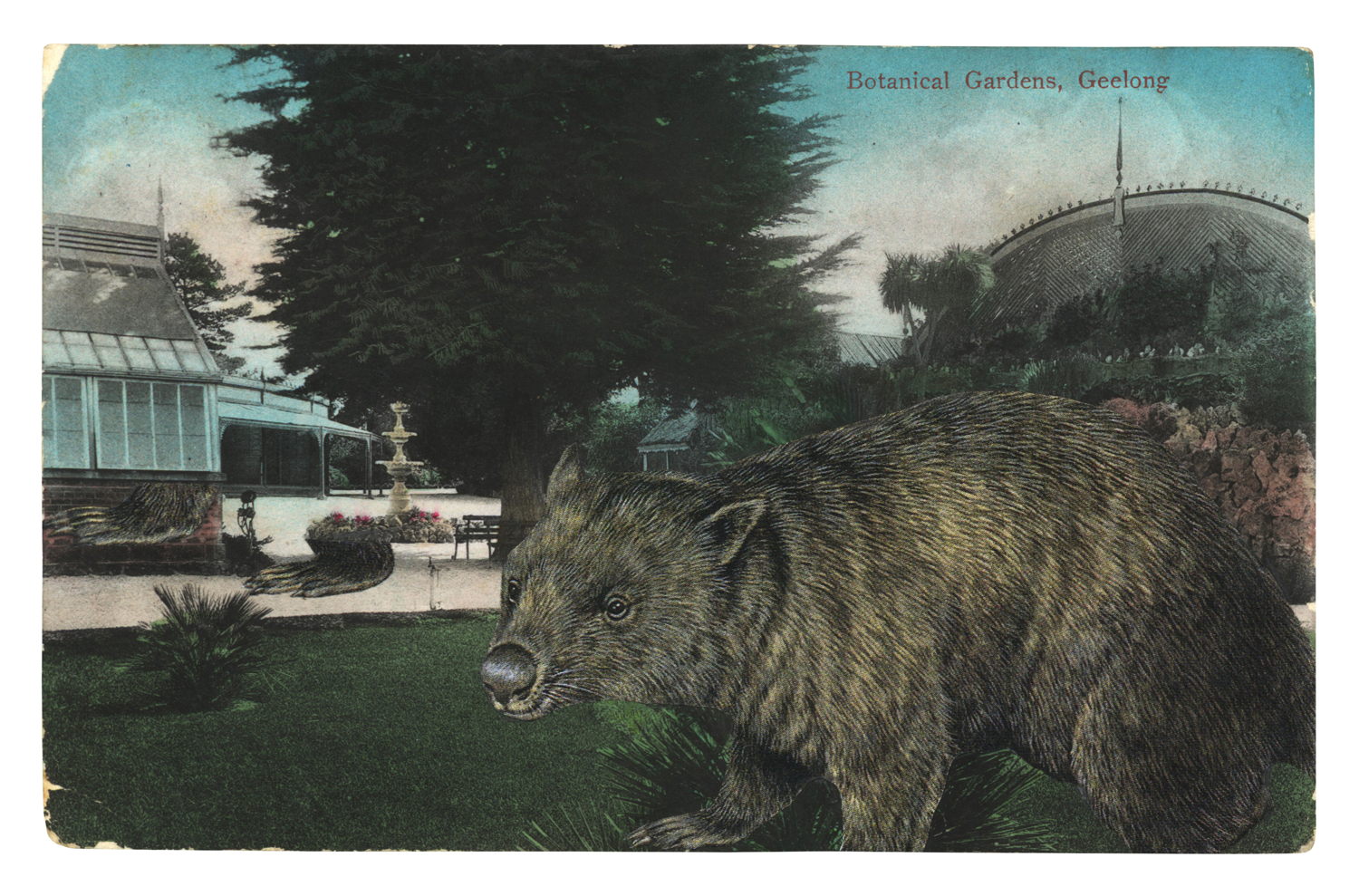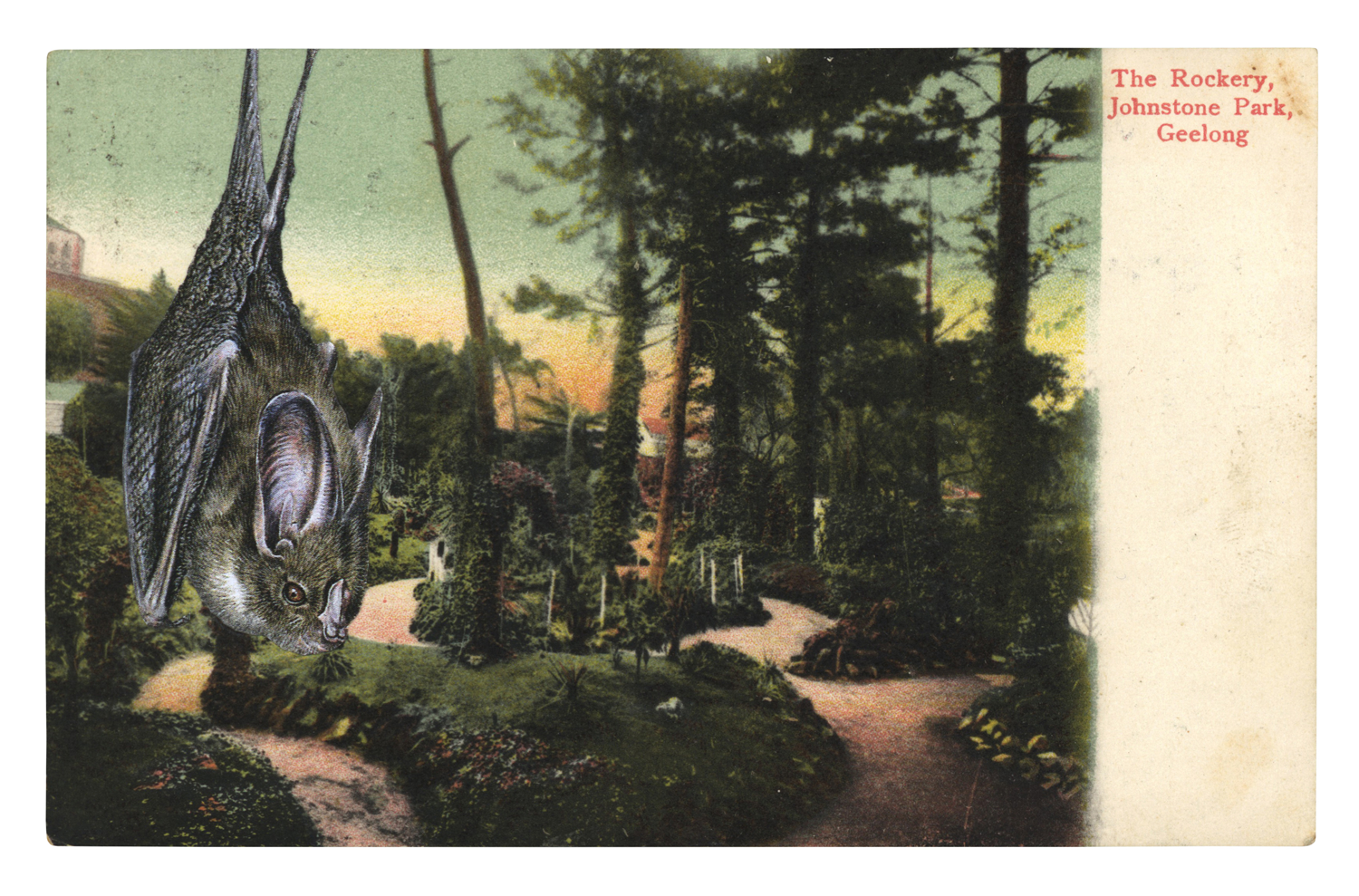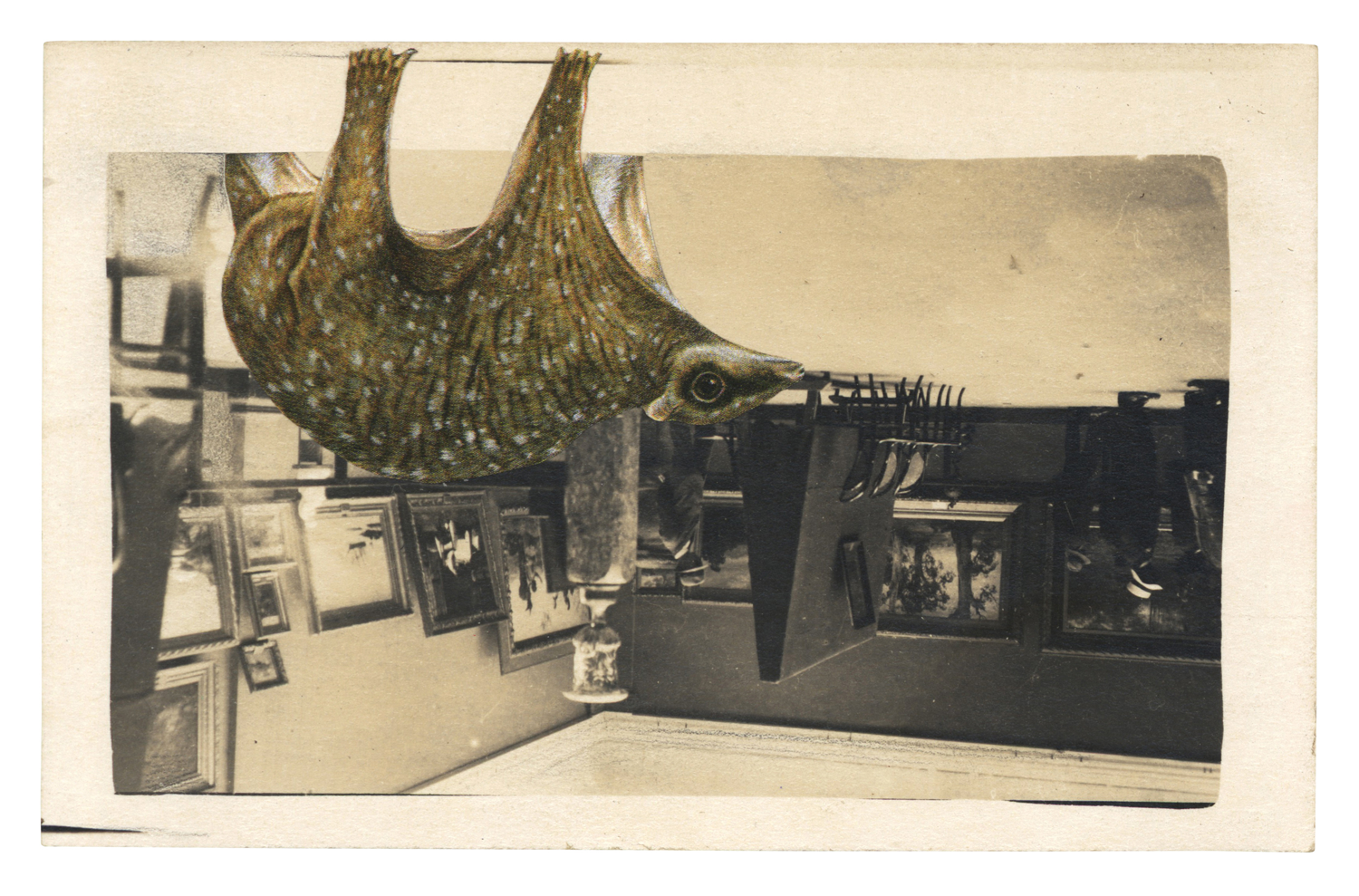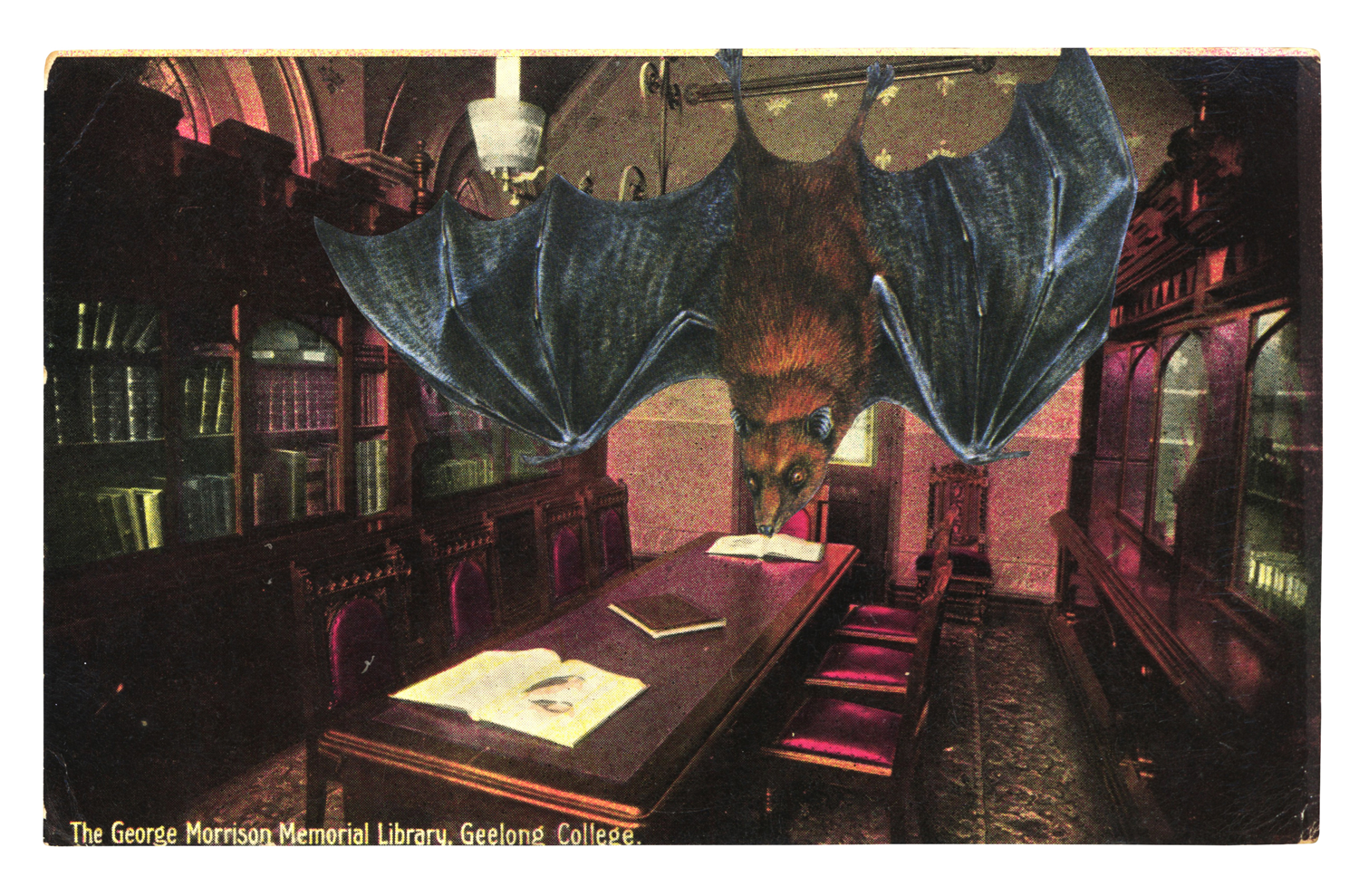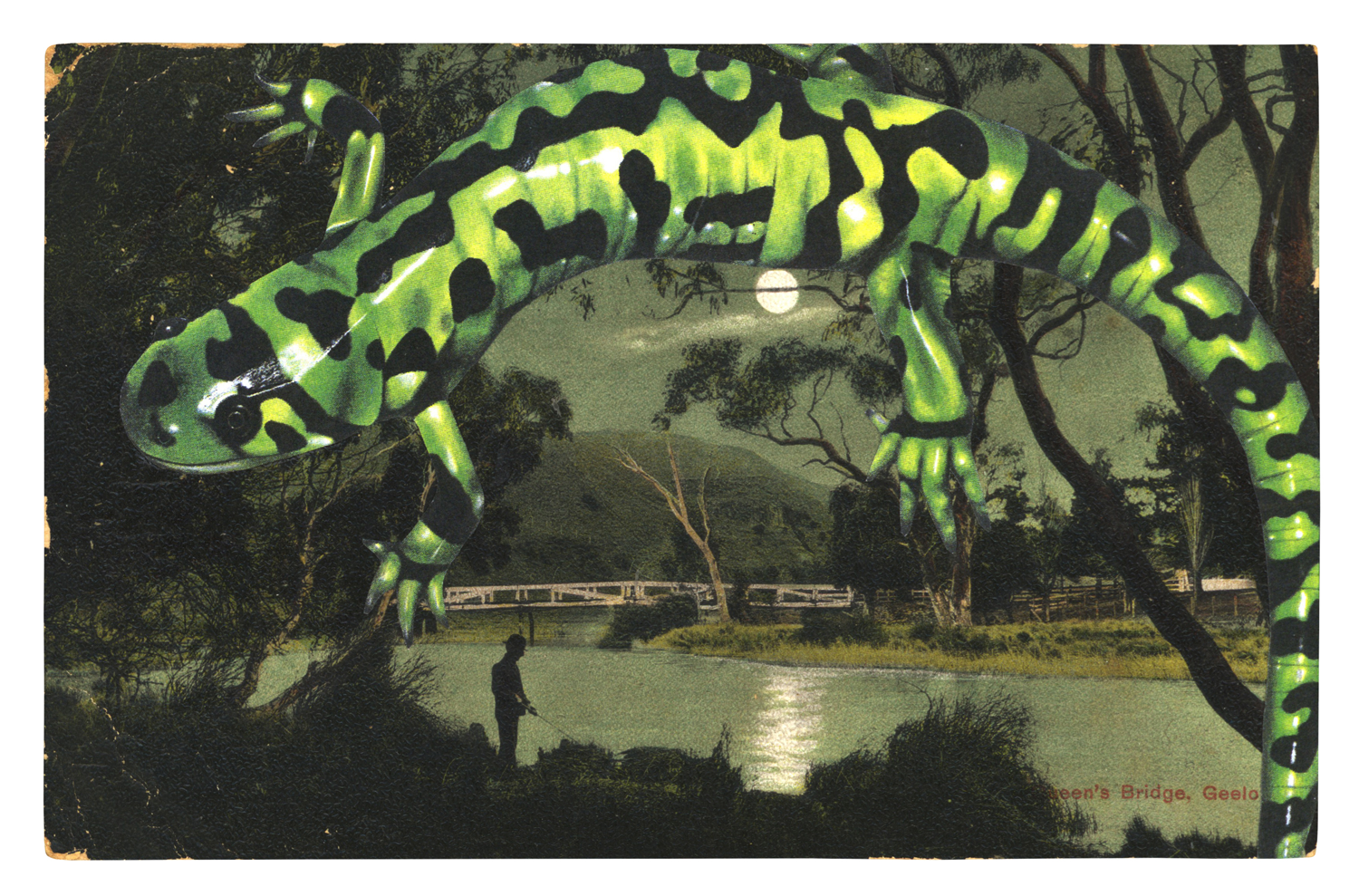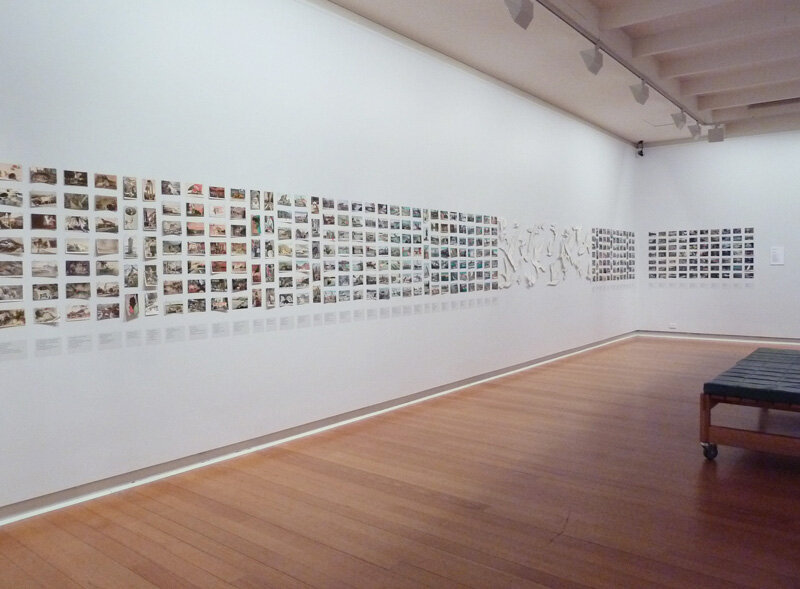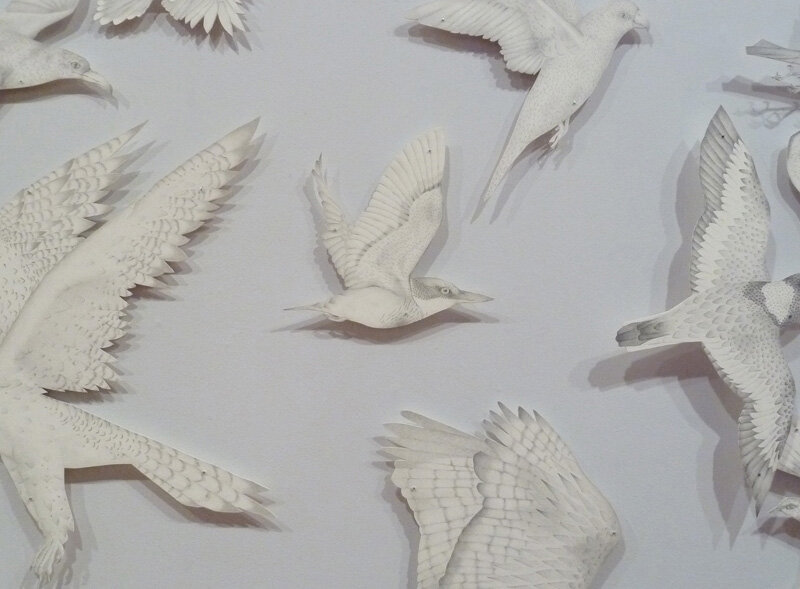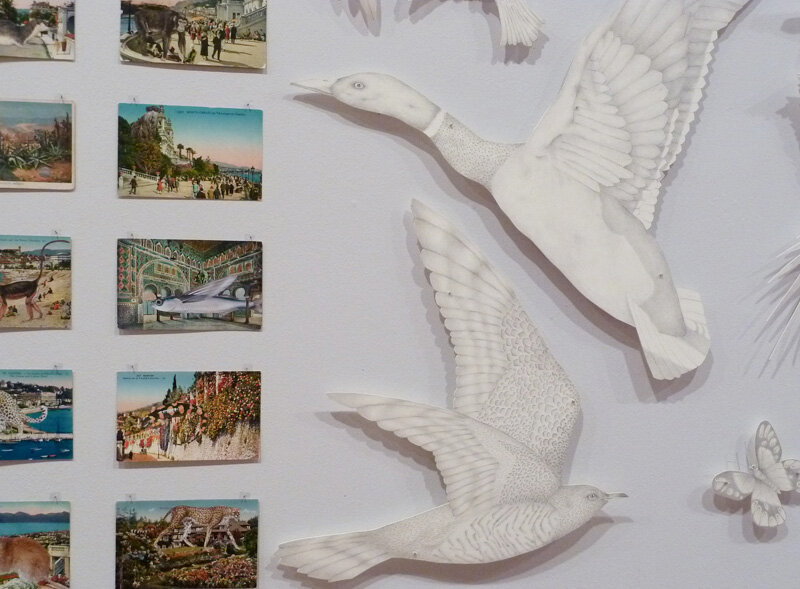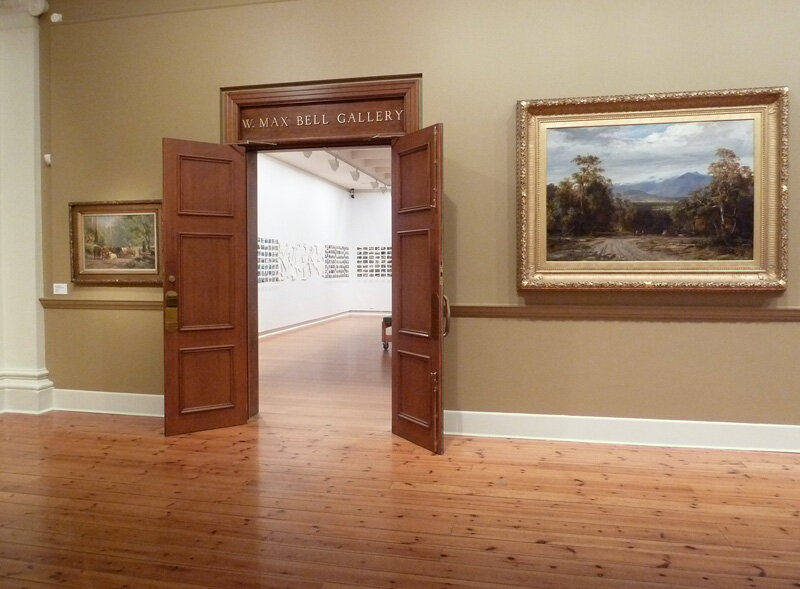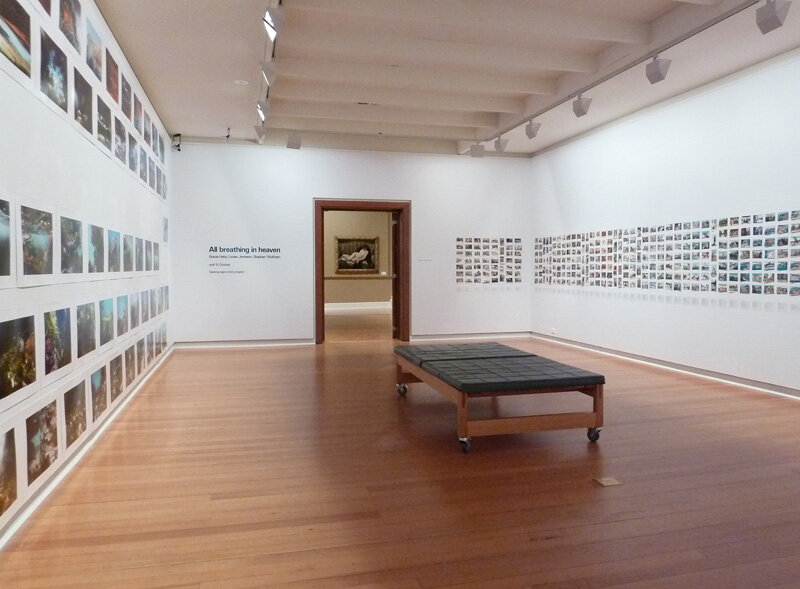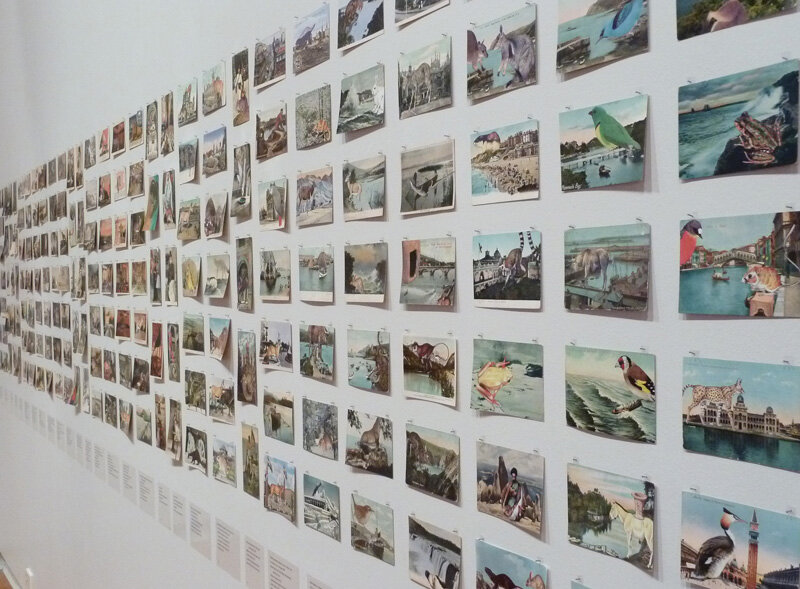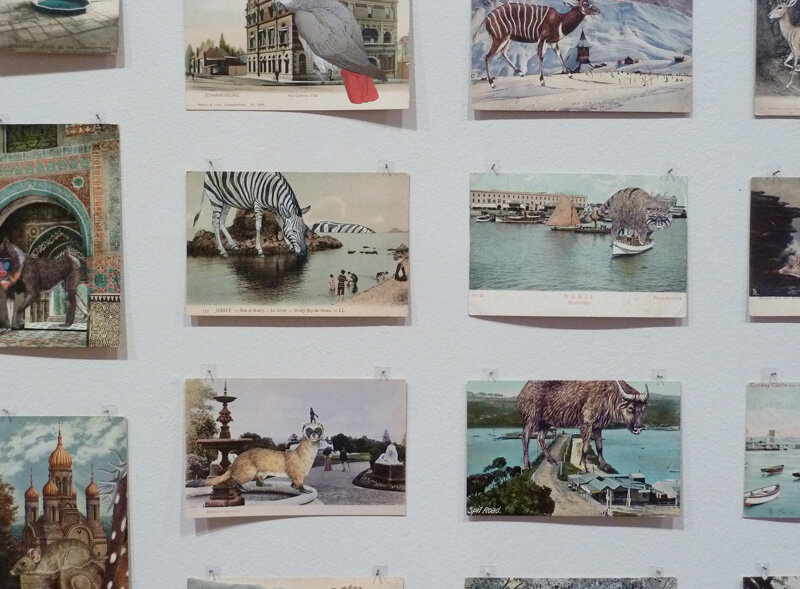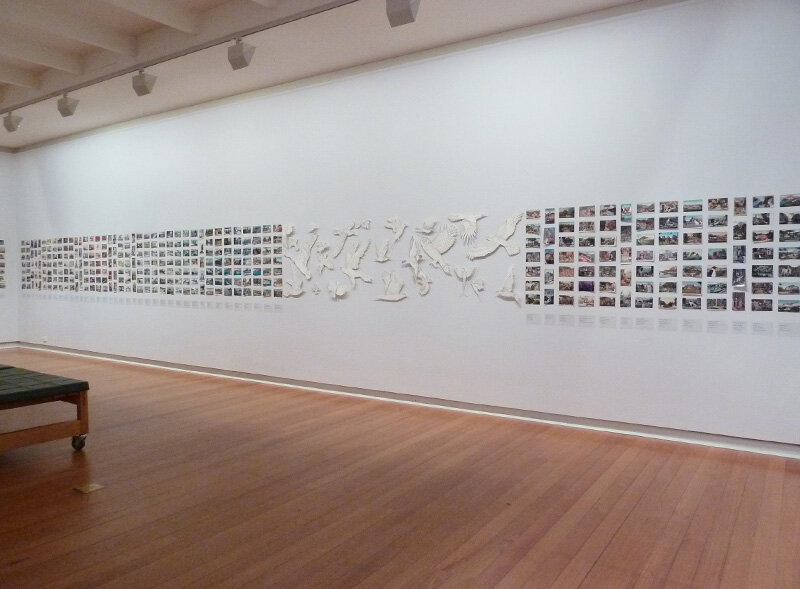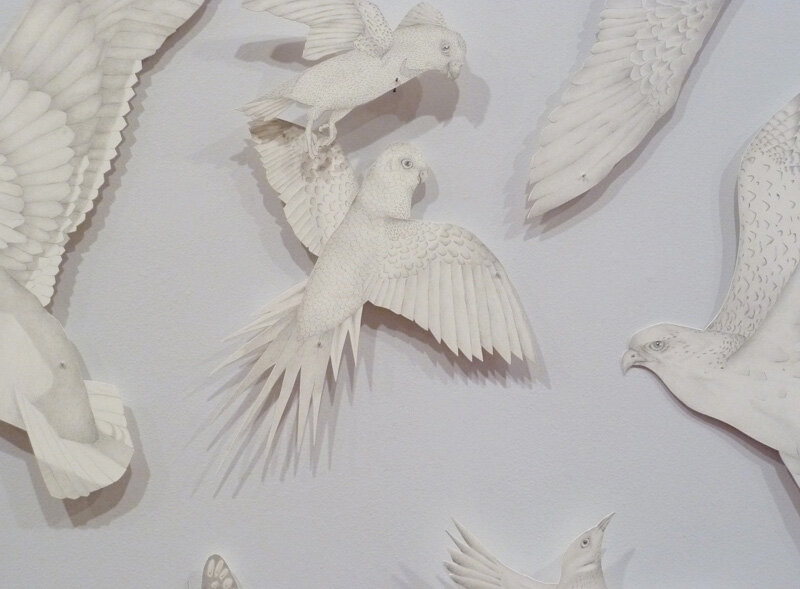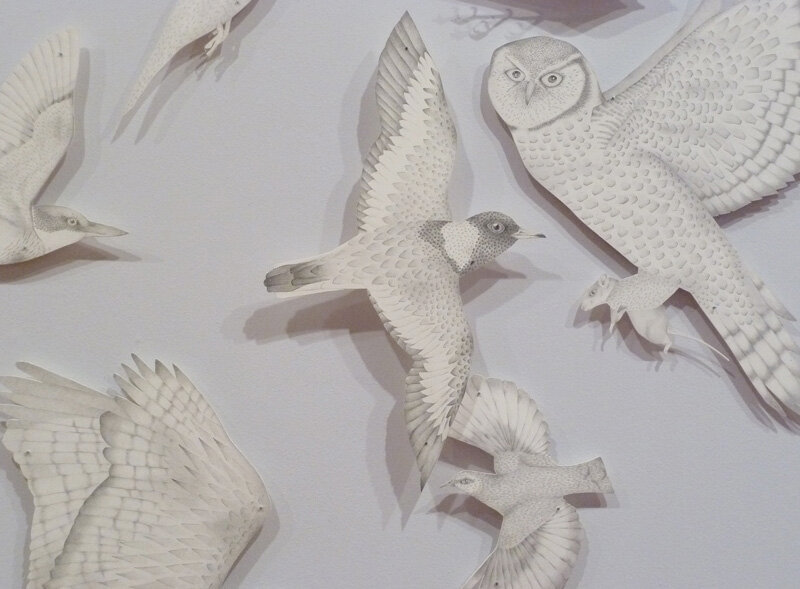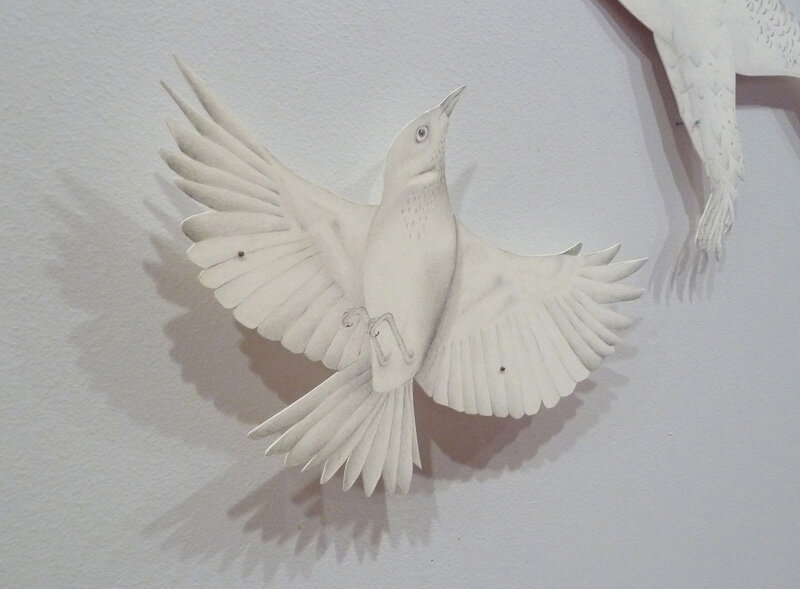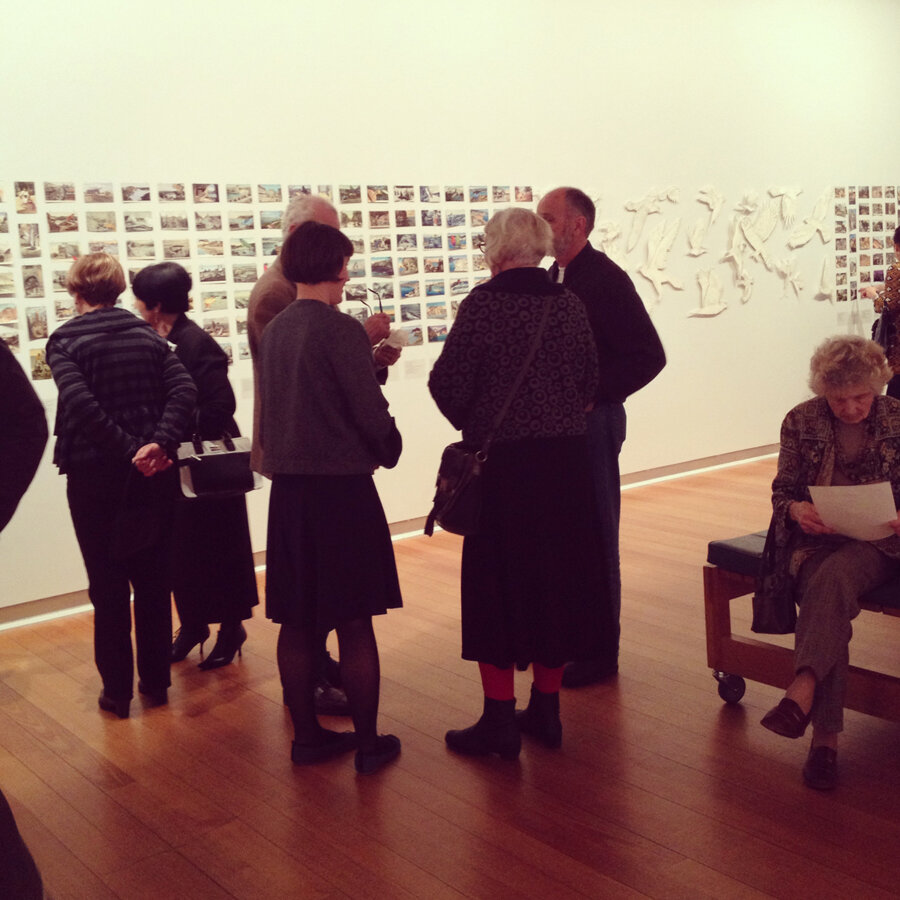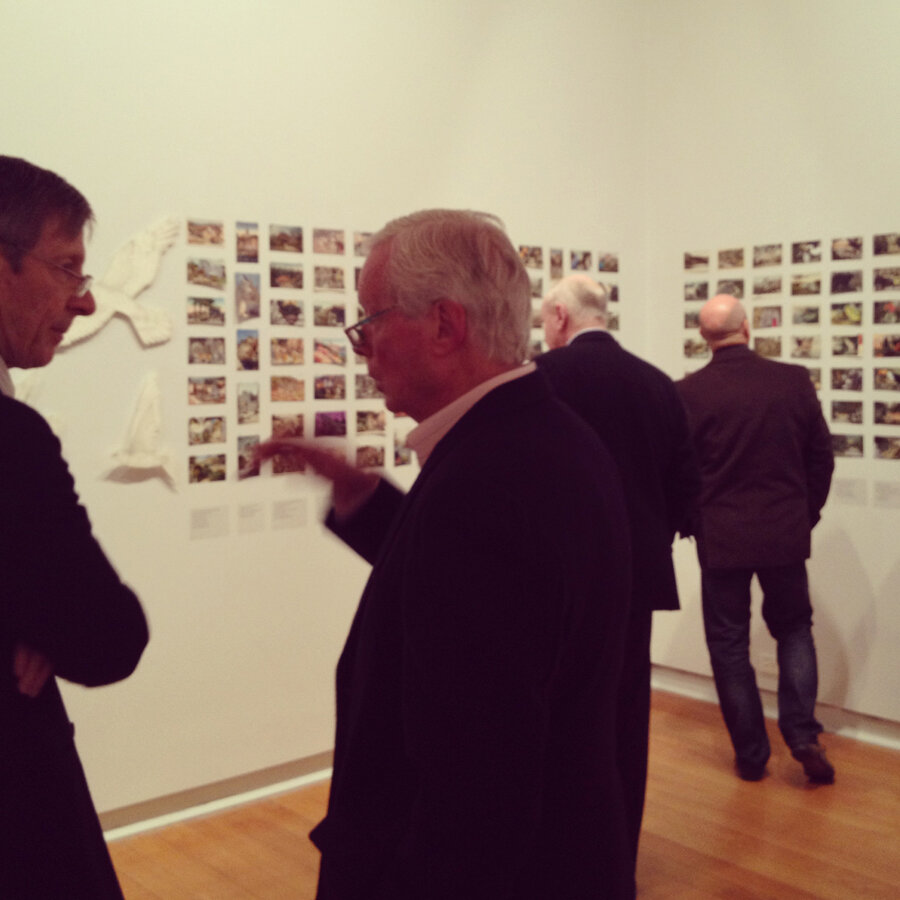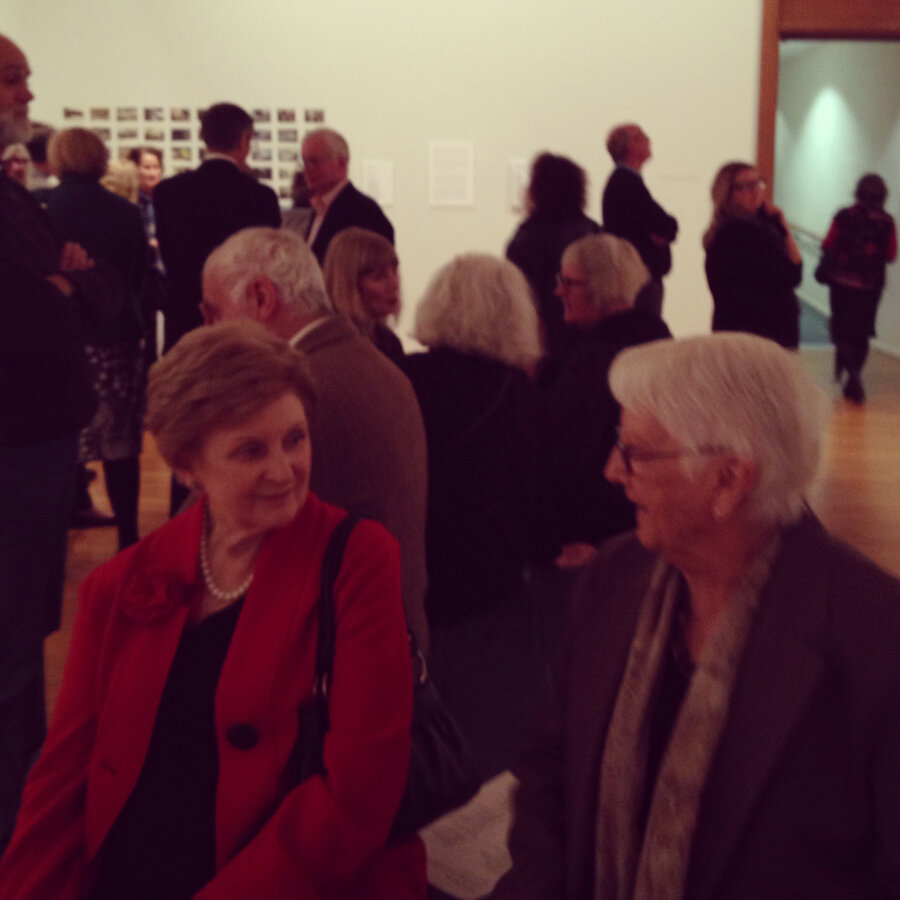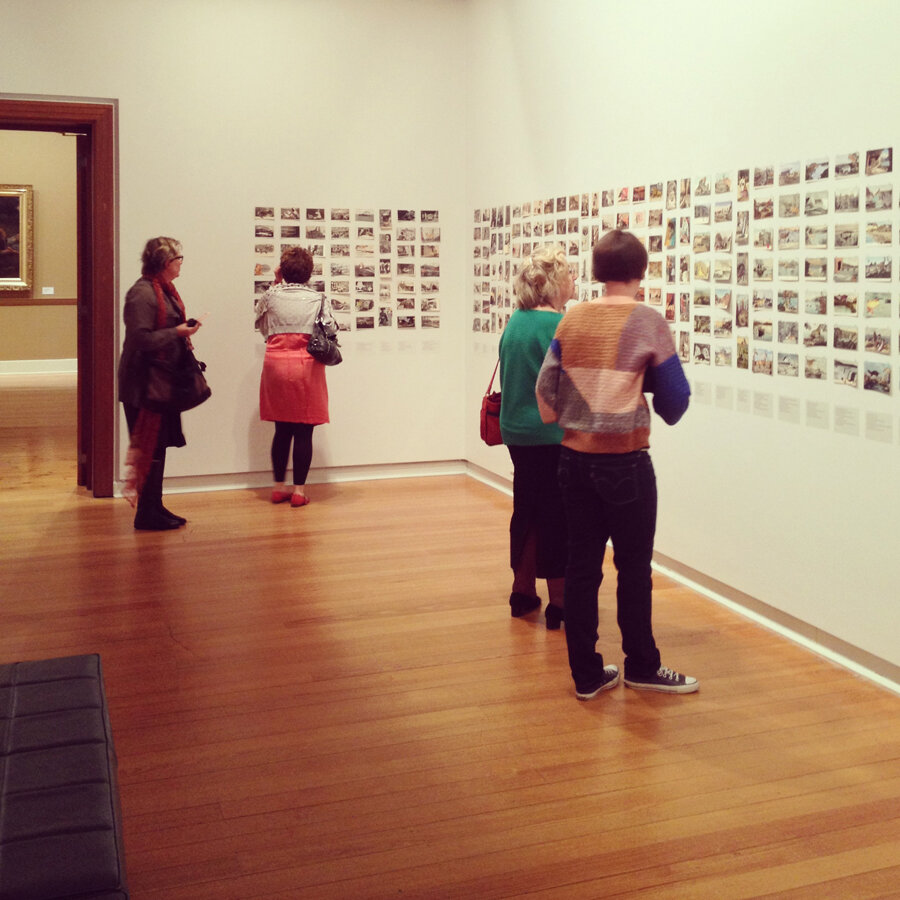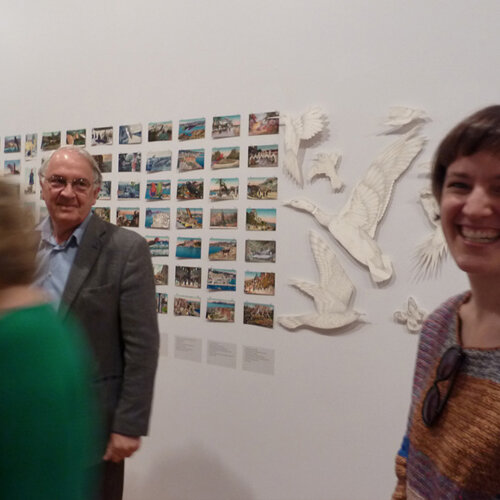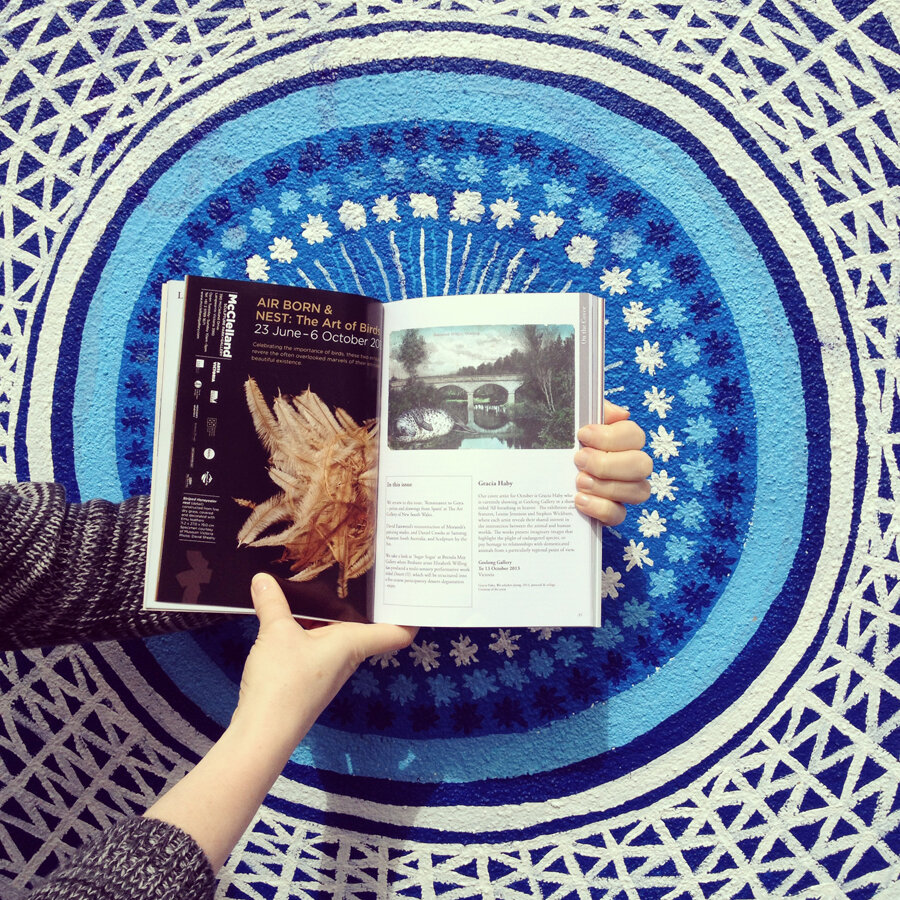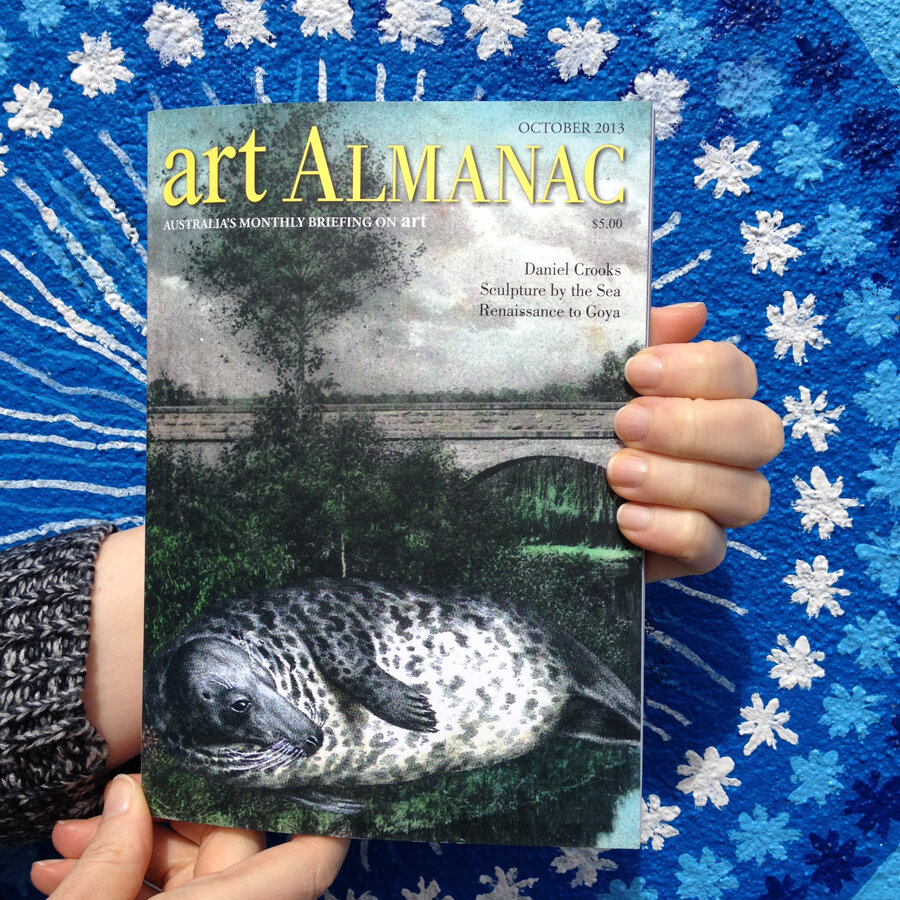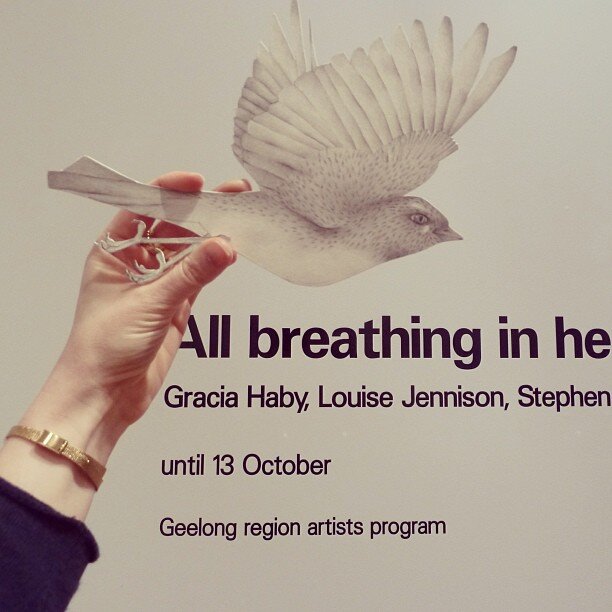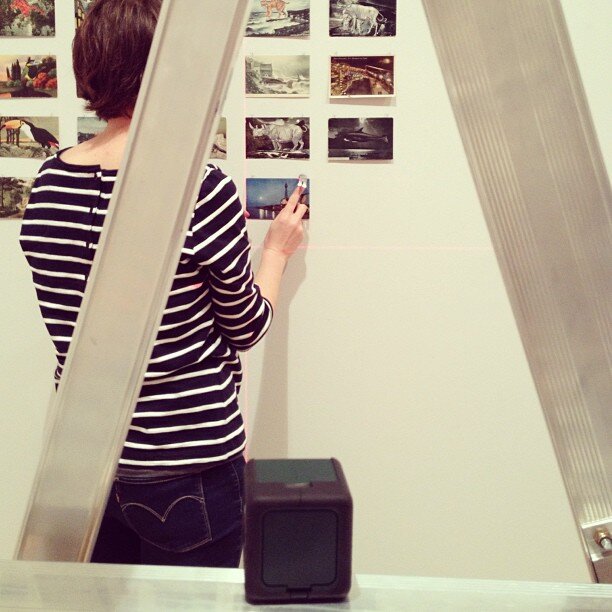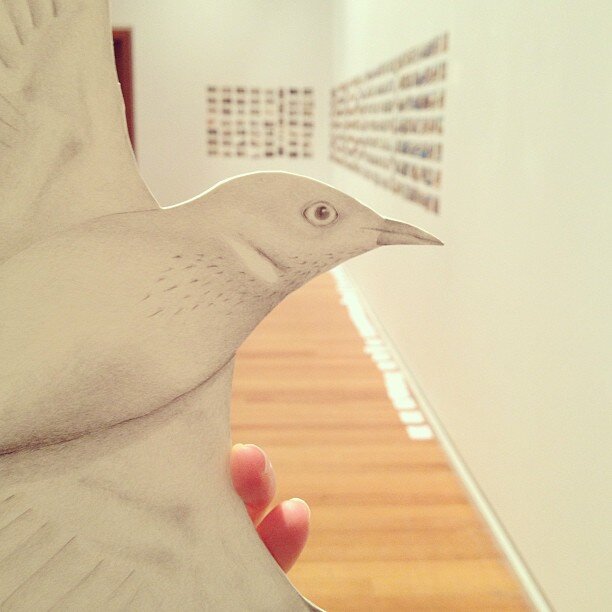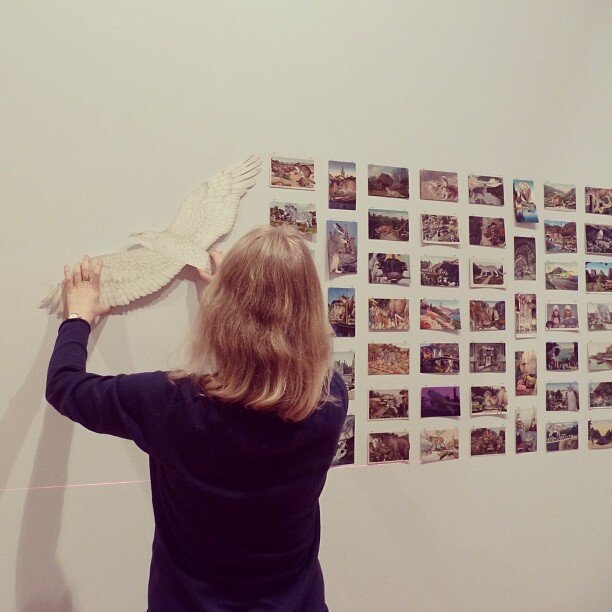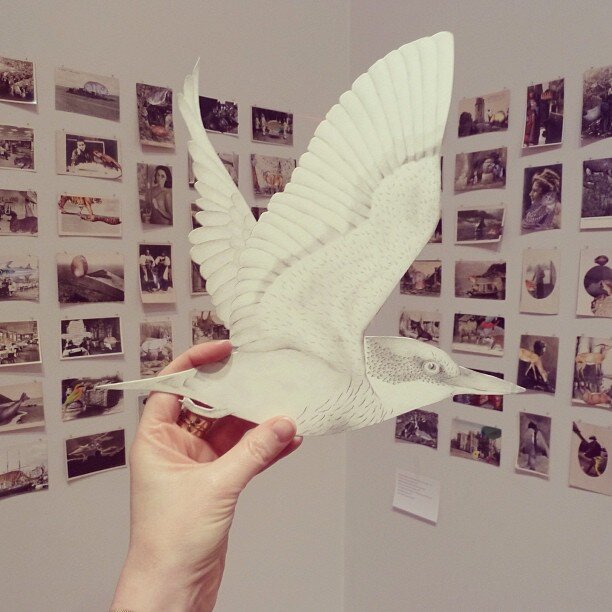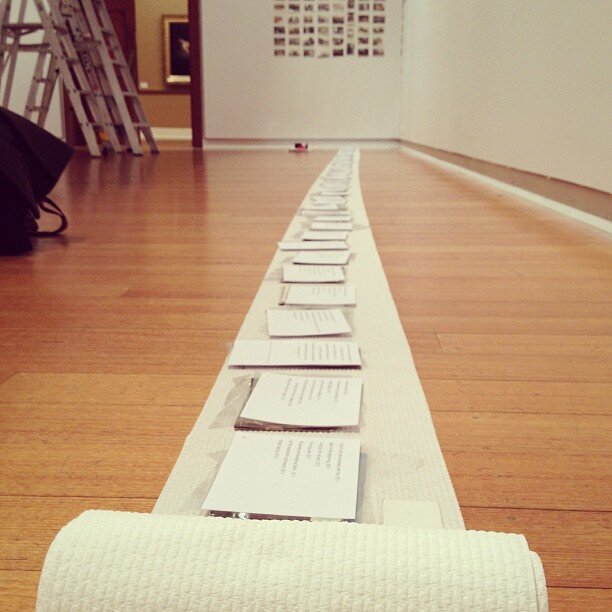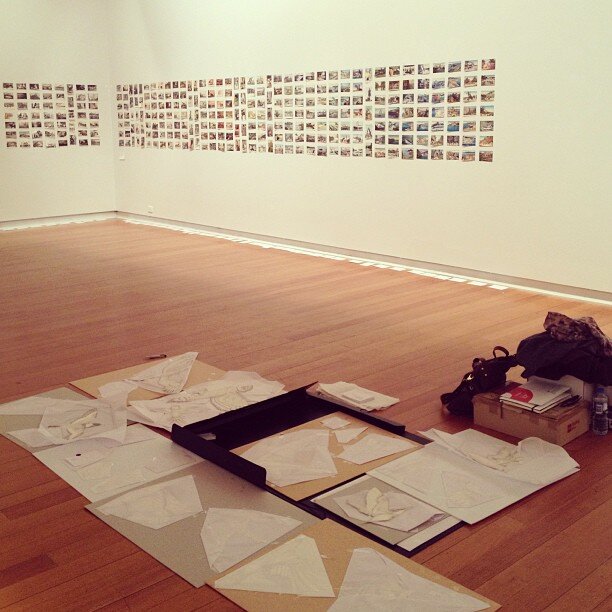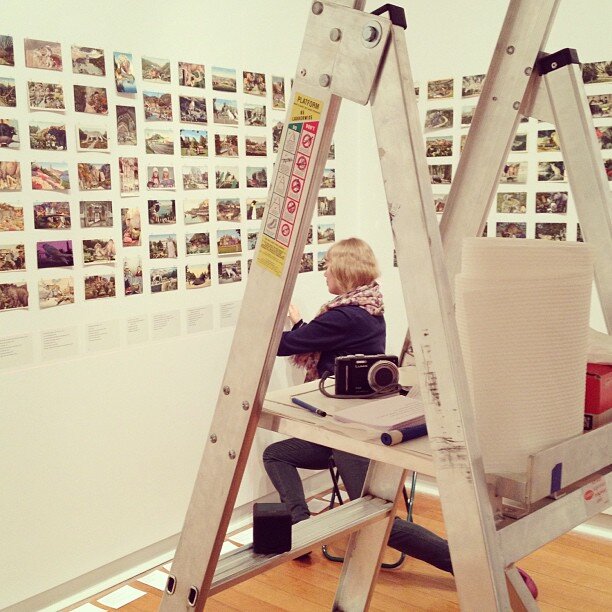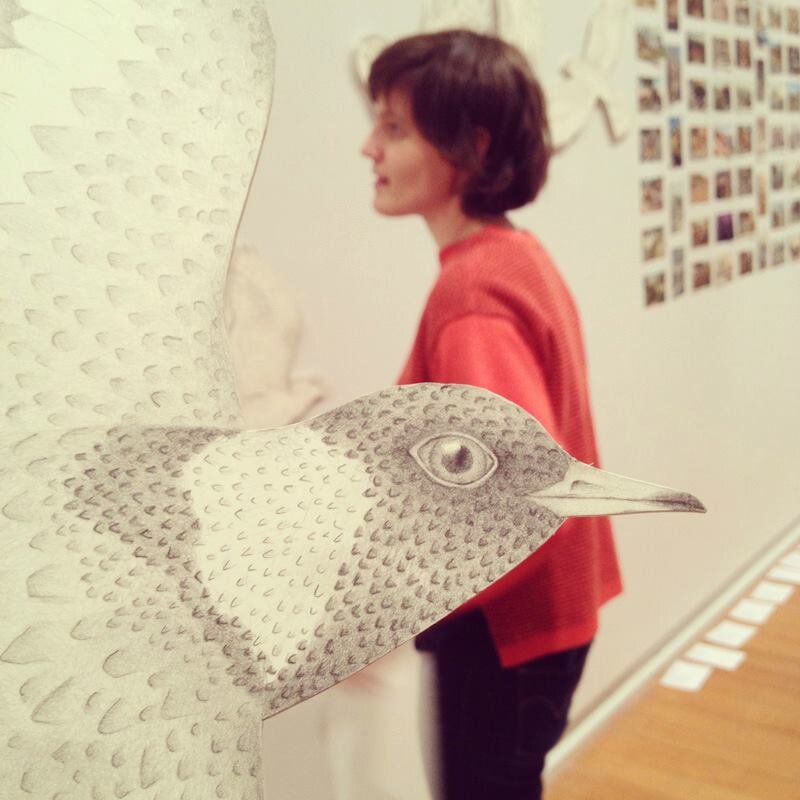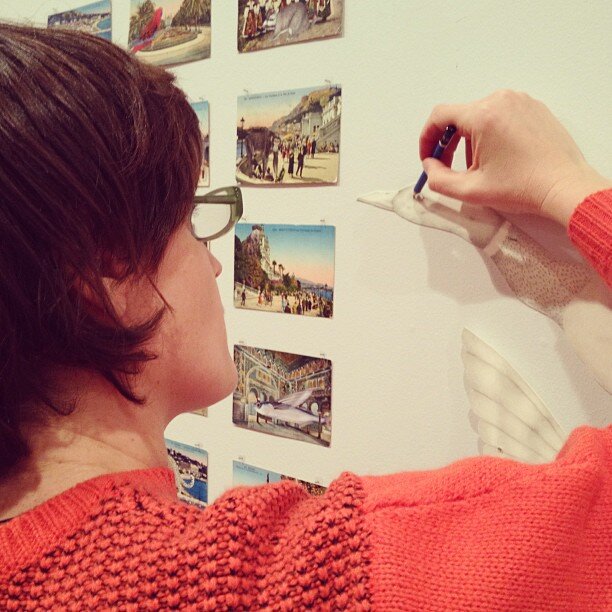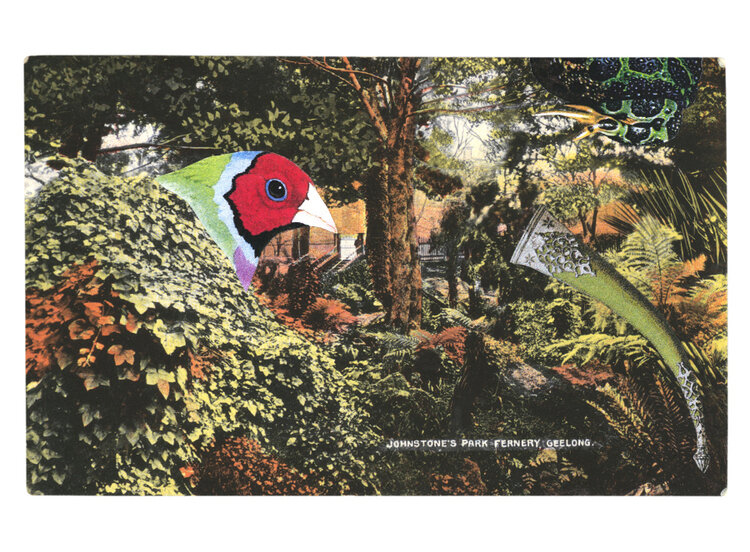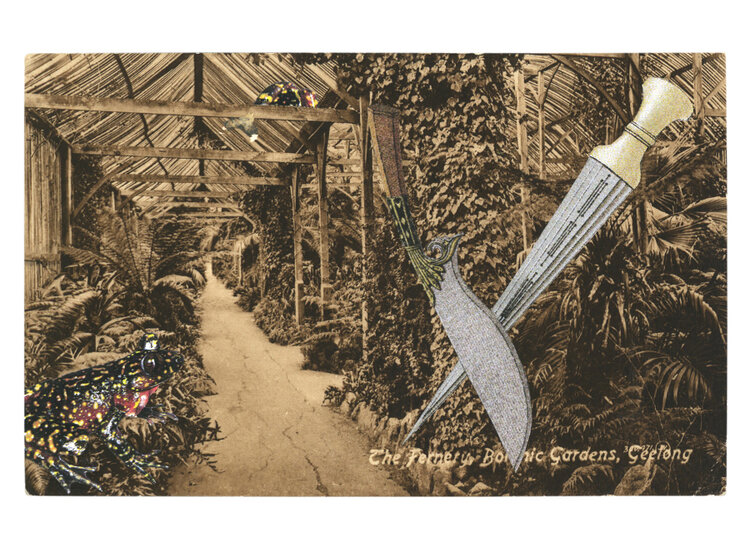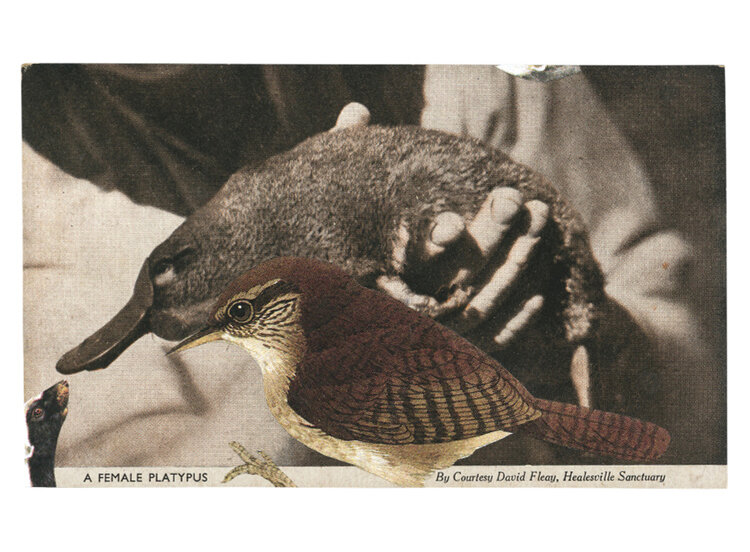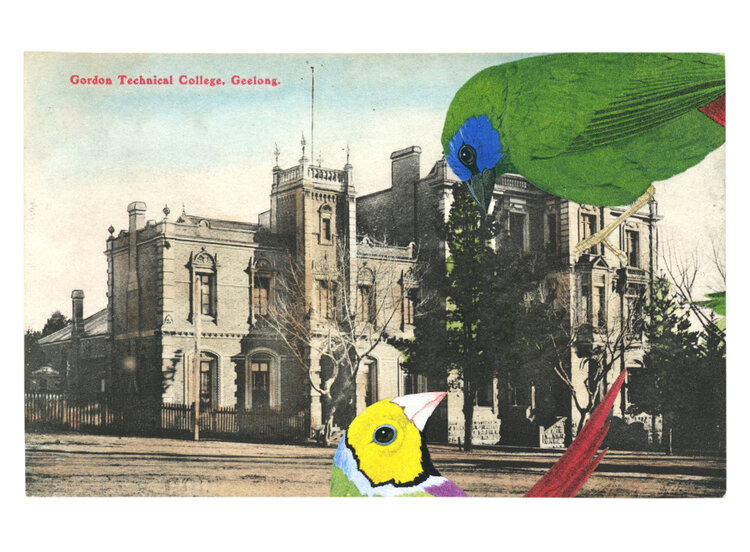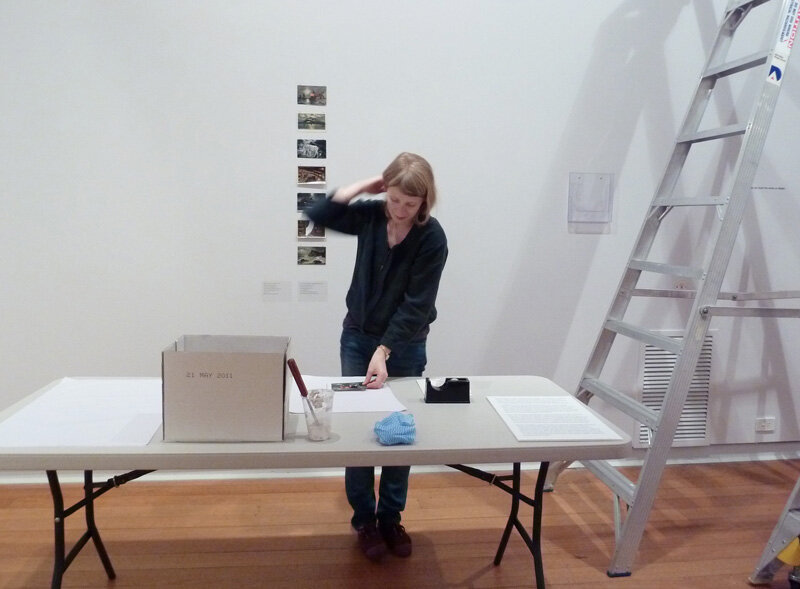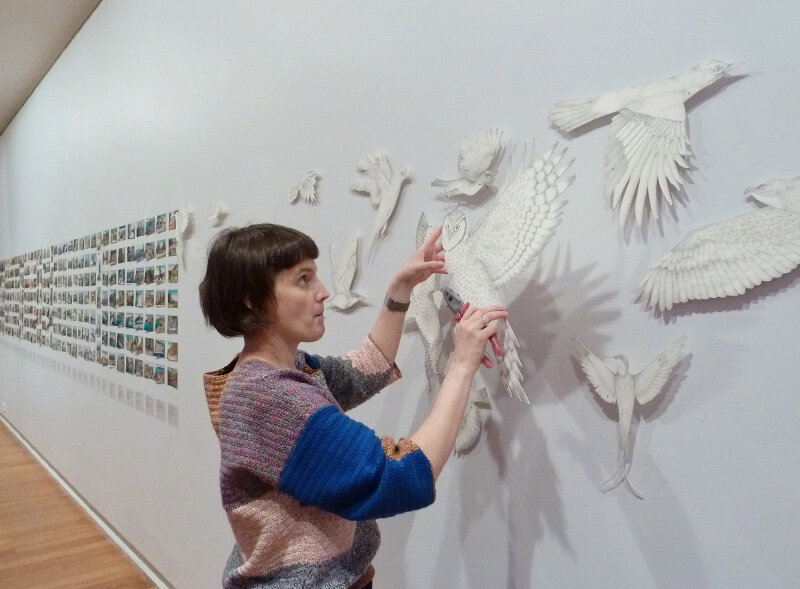ALL BREATHING IN HEAVEN
“Bringing together collage, drawing and photography, the exhibition reveals the artists’ shared interest in the intersection between the animal and the human worlds.”
Gracia Haby & Louise Jennison, and Stephen Wickham
All breathing in heaven
2013
Saturday 17th of August – Sunday 13th of October, 2013
Geelong region artists program
Geelong Gallery, Little Malop Street, Geelong
In conjunction with this exhibition, our artists’ book, As inclination directs, was on display as part of the 2013 Geelong acquisitive print awards (at Geelong Gallery from the 31st of August to the 24th of November).
All breathing in heaven list of works (13 page PDF)
●
Wet whiskers drying
Gracia Haby
Postcard collage detail on the cover of
Art Almanac: Australia’s Monthly Briefing in Art
October, 2013
Our cover artist for October is Gracia Haby who is currently showing at Geelong Gallery in a show titled All breathing in heaven. the exhibition also features, Louise Jennison and Stephen Wickham, where each artist reveals their shared interest in the intersection between the animal and the human worlds. The works present imaginary images that highlight the plight of endangered species, or pay homage to relationships with domesticated animals from a particularly regional point of view.
Geelong Gallery
To 13 October 2013
Victoria
Art Almanac
﹏
RELATED POSTS,
BUILDING COLLAGE CASTLES IN THE SKY
SPEAKING OF COLLAGE
NO LONGER ALL BREATHING IN HEAVEN
DOWN SHE COMES
LAST THREE DAYS IN THE GALLERY
CLOSING SOON
A FISH-EATING AQUATIC MAMMAL WITH A STREAMLINED BODY AND FLIPPERS
COME ALONG, ONE AND ALL
WITHOUT AN ENVELOPE
HAPPY, HAPPY, HAPPY BIRTHDAY
WINGS AND BEAKS ON DISPLAY
THANK-YOU. THANK-YOU. THANK-YOU. A NONET OF WHAT WAS.
"DO THEY EVER SLEEP?"
COME ALONG, DO
HAWKS, DOVES, SEALS, AND BODIES
Q&A
ALL FLYING, ALL DONE
THE BEAUTIFUL SET-UP
POST MIFF 2013, POST GEELONG GALLERY INSTALL
JIGSAW COMPLETE
THE SPATIAL ARRANGEMENT
SEVEN VIEWS
BRINGING TOGETHER COLLAGE, DRAWING AND PHOTOGRAPHY
THE ART OF THE MOONLIGHT MELD AND OTHER RECENT COLLAGES
A HOODED PLOVER IN HAND
All breathing in heaven
Geelong Gallery
Bringing together collage, drawing and photography, the exhibition reveals the artists’ shared interest in the intersection between the animal and the human worlds. Combining humour with acute observations of both wild and domestic animals, the works present imaginary worlds, highlight the plight of endangered species, or pay homage to relationships with domestic animals.
Gracia Haby’s whimsical and otherworldly series — of over 450 postcard collages — depicts a menagerie of wild or endangered animals inhabiting well known and recognisable locations (including those of Geelong and its region). These playful narratives evoke a bygone era where animals of all shapes, sizes and origins were free to roam. Haby’s series invites the view to ponder if the creatures are scuttling or seeking shelter, while the title of each scene serves as a clue (and sometimes a red Herring).
Within the formal grid of postcards, Louise Jennison’s drawings of a flock of birds and a butterfly give the initial appearance of flight, but on closer inspection, each bird or insect is pinned to the wall like specimen collections of old. Amongst the array of birds, Jennison’s installation draws attention to the plight of the Hooded plover, a bird that lays its eggs and raises its young on the beaches of Ocean Grove, Barwon Heads, and Breamlea, which is under threat of extinction due to unleashed dogs and human trampling.
Stephen Wickham’s tableau of colour photographs, contemplates the poetics of loss, love and transience within the setting of the Barwon wetlands. Featuring over 60 photographs ranging from moody cloudscapes to the underwater depths of marine life, this selection represents a world shared by animals and humans. Although absent from these photographs, the titles of individual works allude to the artist’s much-loved canine companion, Peppie, as well as the landscape and experiences they shared together: producing a poignant portrait of loss.
Show of the Week: Take Flight
Ramona Barry
handmadelife
20th August, 2013
Two of our favourite artists/collaborators have been so so very busy this past few months. Gracia Haby and Louise Jennison have achieved what would be impossible for us — have work ready for a new show and go to over 40 films at the recent Melbourne Film Festival. Do they ever sleep?
Geelong Gallery plays host to their latest show All breathing in heaven which continues their exploration of both animal and human worlds and where they intersect. Through the time honoured traditions of collage and drawing these two magical makers have created a world of their own that is totally beguiling.
The ladies of hml are big fans, having bought journals, zines, prints and collages in the past so we cant wait for the road trip. How amazing to see so much of their work on display. We often joke that in some parallel universe we would be as talented, intelligent and beautiful as these two and produce work as seductive. We will have content ourselves with being fans and collectors.
Q&A with Timothy Roberts for The Lives of Animals — Gracia Haby
St Michael’s Grammar School alumni publication
16th August, 2013
Can you describe the major themes of your current exhibition?
On the eve of our five-day-install of our work at Geelong Gallery, we are looking forward to the whole glorious process. Louise Jennison and my work for this exhibition, All breathing in heaven, is part of a three-person exhibition with Stephen Wickham. In reply to Stephen’s photographic grid (along one wall of the gallery space), 464 of my postcard collages will be arranged in columns dictated by colour and 23 of Louise’s birds (with one butterfly included) will appear to take flight. Louise’s birds have initial appearance of flight, but are actually pinned to the wall like specimen collections of old. Beauty in its place, tagged and recorded. These hand-drawn birds of Louise’s have nowhere to fly in the gallery; this is not their habitat. They will be boxed within my postcard collage grid. With my postcard collages (previously exhibited at Latrobe Regional Gallery as part of our exhibition By This Unwinking Night (2012), and including new postcard collages set in Geelong), I am chiefly looking to add one thing only to the scene that will alter its reading. Sometimes the new animal inhabitant will be hard to spot, a chameleon camouflaged in the floral arbour, and other times it will dominate the landscape. For me, it is what the animal I have collaged in place is doing that is of interest to me and what I see these works to be about. Are they scuttling or seeking shelter? The title of each scene, too, will serve as clue. (It will also serve as red herring.) This configuration along one long gallery wall features collages from 2006 to 2013 that will give way to Louise’s birds. It includes collages created as part of my Dear You series in which I write the narrative on the reverse side of the postcard too. Many people think I have found them this way, with a story on the reverse, which I find amusing. For me, like titling an artwork, it is another space in which to play and direct reading.
How long have you been collaborating with Louise Jennison? How did you meet, and what do you each bring to the creative process?
We met at RMIT in 1994. We were both studying Painting (BA in Painting with Honours, 1994–97), and, along with a couple of others also straight out of secondary school, a bond formed. We worked side by side in the studio or were involved in group exhibitions together. We soon discovered that we each liked each others working methods. There are a great many less creative parts to staging an exhibition (the business nuts and bolts of any endeavor) and you need to put in a great many hours, so to find someone who is equally dedicated to this was essential.
Over the years, we have each set to polishing different skills in order to each bring something different. There would be little point in collaborating with yourself. But we also have a great many similarities too and our collaboration is one of harmony not discord. At this stage, we are not looking to create works from a collaborative tension between the two ways of seeing. We are looking to make artists’ books or prints or drawings that without the other would not be possible.
In our recent collaborative artists’ books, such as Beneath the screen of closed eyelids (Port Said) (2012), I have collaged over scenes completely hand-coloured by Louise. Who knows what we will do in the next. This is half the fun.
Working collaboratively is also another way, for us, of getting more things done. As I take care of the website, Louise is putting tabs on the postcard collages for gallery install. 928 tabs, two on each collage, perfectly spaced. For each of us, it is almost like having another pair of hands.
You have stated that ‘the animal is there to question our very behaviour, those moral principles one governs the self by, and to explore the relationship with the natural world.’ How does your current exhibition expand on these themes? Does your art have an overarching moral theme or message?
I am primarily interested in what the animal in my collages is doing more than what type of animal they are (that is secondary). I am interested in putting them in scenarios both obvious and less so. Some promenade through a scene whilst others lurk seemingly undetected, such as in my artists’ book Testing the laws of hazard (2012). Most are out of proportion with their environment. They don’t fit and yet they do, such as in my artists’ book, All that’s bewitching by the water (Capri) (2012). Most are in some ways a self-portrait of how I see or feel my own place in the world to be. With Louise’s birds, the important part is the environment you do not see. In my works there is a landscape but it might not be the right one, and in Louise’s works there is no branch or nook. Upon first glance, I think our work looks cheerful, but upon closer reflection it is anything but. We use the animal almost as a lure to pull you closer.
We also try to leave our works open-ended. You can see in them what you will. You can make of them what you will. You can see yourself. You can see your own link or association with nature. You can see human nature reflected in the movements and actions. You can see charm. Along the way, some people have seen our zines to be artists‘ books, or our ‘this’ to be ‘that’ and as this is something beyond our control, we’re fine with that.
Can you describe your method of collage? What makes the medium so compelling for you?
I have been using collage for many years now. It crept into my works at RMIT and made itself a nest. By the end of my course, I was no longer using brushes to paint with but brushes to apply the glue to reverse side of collage. To my way of thinking and working, it felt a natural fit with artists’ books. The two went hand-in-hand. The two, collage and artists’ books, were also extremely portable and required very little by way of space. Just as there is always room to be found to draw in your sketchbook, there is little that prevents one from creating collage. This practical approach was a way to ensure I kept working regardless, a way to push aside the obstacles. All of my work can be done on a large drawing board, anywhere, but space to think is a necessity. I cut out all of my pieces in advance to making. I store them in a large clear folder. This is my palette. This can be likened to mixing pigment. This part of the process requires different thought. I cut out pieces slowly and with a small sharp pair of scissors. This enables me to get in small spaces between a bird’s claws or a creature’s horns or antlers. When it comes to making a collage, I will work on about ten or more at the one time, and I will interchange the pieces until I am sure that every character or element is where I want it. I play with the options I see and decide on which I prefer. At the end of this process, there will be several works ready to be glued in place. Gluing pieces in place requires good light and patience. It is where mistakes can occur, so snouts of rodents are glued in place first and then the rest of the body, or the bird’s feet are lined up with their support or horizon line. I glue the part I am most particular about its exact position first and work outwards. They may be small pieces, but I glue each piece in several stages, smoothing them out as I go.
I enjoy the whole process of collage. It is flexible, and, for me, the best way I know to create what I see in my mind’s eye. I also create digital collages and the process here is quite different. Here, it is about layers one on top of the other (say, forty or more) that are then stripped back to reveal what lies underneath. The collages by hand conceal what lies beneath. Digital collages have a wider source pool of imagery to employ and for this reason are equally exciting. In our artists’ books and zines, both feature, as well as Louise’s drawings with pencil, watercolour, or sometimes pen.
Can you discuss your experience with Art at St Michael’s, including notable pieces, teachers you remember, etc.?
In retrospect, I loved my time studying Art and Studio Art at St Michael’s (in the late eighties, early nineties). They were the periods in the day that flew by. The art department felt giddy world away in every sense, and not just because it was separated by a laneway. In addition to the practical side of study (from colour mixing to folio preparation), I enjoyed the challenge of Art History, of peeping at the wide world and scratching deeper. A good point from which to leap, I remember discipline fused with enthusiasm, two necessary requirements.
(I have but one chief regret and that is that I dropped out of English Literature before semester start in my final years at St Michaels. Though I’d read over the summer and loved the texts set, I, at very last minute, doubted my abilities. I am since learning to work through doubt.)
When did you realise that you had artistic talent? Did you pursue this throughout your School years?
I have always drawn, scribbled, and collaged as a means of amusement, and I hope I always remain to do so. It is easy to place obstacles of time and finance in your way. “I don’t have time to work” or“I don’t have the money and/or space to make what I want”. I like to work with these restrictions. Almost anything can be used in a collage.
In a recent documentary I saw on filmmaker Michael Haneke, I particularly liked how he spoke about the privilege of being able to pour all of your neuroses into a creative outlet, and of taking your audience seriously. It is good advice, and it is true. It is a privilege, this creative outlet. It also takes a lot of determination to keep going in the face of funding rejections and other setbacks, but what else would you do if you didn’t make things?
Which artists influence your work, and what have you gained from them?
Many. All. Everything you see can in someway influence you. What you like and what you dislike. The important part is being able to recognise why you like or dislike something.
On the back of the Melbourne International Film Festival, having seen fifty-three films in a short period, the works that are inspiring me at present are some of the great films I have seen. Bahman Ghobadi’s Rhino Season was exquisitely framed. Starring the exiled Iranian actor Behrouz Vossoughi, for me, it showed through symbolism what it might feel like to be released from prison after thirty years. Water appears in almost every scene as a device to recall memory, and you could pause the footage anywhere and a painting composition is apparent. Jem Cohen’s Museum Hours also read like Ways of Seeing in film format, and Nicolas Rey’s differently, Molussia with it’s use of a wind camera becomes an automatic drawing.
Dance is also inspiring to me, perhaps because it rarely has an actual (speaking) voice yet it can communicate, impart, reveal, explore so much. I am also greatly drawn to its seemingly collaborative side of so many people all working towards the one goal of creating and presenting a great work. Philippe Béziat’s film about the creative process, Becoming Traviata, was inspiring for this reason. The close look at the rehearsal process of staging an opera showed the dedication, devotion, and hard work required of all involved. Necessary requirements, you see.
All this and we’ve yet to talk about the influence of books read. Let’s leave it at many, all, everything.
In an article on Swan Lake, you exalt the work for its ‘romanticism impossible to resist or ignore.’ Can you discuss your musical inspirations/leanings?
Classical music (or silence) is the only music I listen to when I am working as it enables me to ‘see’. It is, I guess, much like a film score, but one that only you hear at the time of making. It enables me to set the stage, to see an idea clearly, and follow it through.
I have recently started writing about the various dance performances I see (for Fjord Review since 2012), and this to me is like collaging not with paper but with words until I get them to flow as I wish. I write my pieces on paper in a messy hand that tries to keep up with the sentences as they form, and later transcribe and flesh out and reorder these on computer. I love writing these pieces, I love the challenge of describing what you have seen and felt, stripping back what is not needed, questioning why you like something, recalling what you felt. I studied ballet throughout Primary School and for most of my years whilst at St Michael’s, and have long been fascinated by what the body can do and how it can move. It is like a piece in a collage for me. A tool. It can describe, communicate, and watching dance, or indeed film, it let’s you, seated in the audience, forget all about yourself. Complete emersion in a moment. You are rendered weightless. You can imagine what it is like to soar. Pyotr Il’yich Tchaikovsky’s Swan Lake enables this, and I enjoy seeing its different stagings. (For example, The Australian Ballet’s performance of Graeme Murphy’s Swan Lake and The Australian Ballet’s performance of Stephen Baynes’ Swan Lake.) Like any work of art, the closer you look, the more you see.
You have created artworks for a number of clients over the years. What is your favourite project, and why?
I have especially loved creating digital collages for The World of Interiors as the process was completely new to me. ‘Illustrating’ someone else’s words is an enjoyable challenge as you decide how specific or abstract you will be whilst sticking to a brief, adding in “a ziggurat of balls of porcelain clay” to draw a point. (For example, Time on his Hands (2012), The Genuine Article (2009), and Greeks Bearing Gifts (2008).) With these works, I create a handful (ten or so) and email them through. These works look nothing like the result on the printed page. They are, though technically finished visually, drafts to polish. They are one half of the page that is image and text and the two need to work together. It is the back and forth of the process that I especially like. As this magazine is based in London, I also enjoy making the most of the time difference, and trick my brain into thinking it is ahead of the (always tight) deadline.
Is there anything else you would like to add to the article? If so, please elaborate.
Think I may have bent your ear for long enough now, but thank-you for asking me these questions.
30 Days of Collage
Q&A with Stephanie Levy for her guest interview series conducted as part of her 30 Days of Collage e-course
November 2013
Gracia Haby & Louise Jennison are artist book makers and collage artists based in Melbourne, Australia. Their poetic images, often featuring animals, have been published and shown in a number of printed and online journals and are exhibited in galleries throughout the world.
Welcome Gracia and Louise! I’m so happy that you could join us here today. Please tell us a little bit about yourself, where you are from, your background, and how you got involved with collage and artist books.
Please tell us a little bit about yourself, where you are from, your background, and how you got involved with collage and artist books.
Sketchbooks, and visual diaries, journals and the small folded drawings one does from the age one can use a stapler (inspired, no doubt by the childrens’ books read at the time), the two of us have been fans of the book in its many guises for a long, long time now, and over the years, we have continued this, sometimes collaborating on artists’ books together, turning their faces closer towards that which we are most interested in making at the time. It is perhaps that no work is ever ‘just so’, just as you’d imagined or seen in mind’s eye, that we keep going, keep working, with books, paper, and collage.
Every step, every part of the process, every learning curve, holds us besotted. We love the challenge artists’ books present, the possibilities, the history they hold, and the intimacy they conjure, all this and the unexplained keeps us working with artists’ books. The flexible medium of the book holds us in its palm rather than us holding the book in our own palms. We seem, for this reason, unlikely to cease making artists’ books. It is often to the cabinet displays in exhibitions that we gravitate to first, and wish that we could turn the pages. Not only do we like their awkwardness to display (where not every page can be seen at the one time), we like the presence they command beneath a sheet of Perspex or glass. Peering down at something so tactile yet untouchable, the book’s magnetic pull is strong.
Aside from all the sketchbooks and visual diaries aforementioned, a quick look over what we have made since 1999 tells me that we’ve made 79 different artists’ books. Some of these have been unique state works, such as Louise’s concertina bound trio, For Martha, An unexpected gathering, and A meeting of parrots that shouldn’t, from 2011–12. And some of these include my own ongoing series of collage books on found sources, such as A different picture with every look (Kjøbenhavn), 2012; A headdress to show you how much I care, 2012; In search of a time the heart does not recall, 2009; and I chanced upon the unexpected and found I liked it (Foregate Library, Worcester), 2009. Some of these are made collaboratively, in limited editions of ten (more often), thirty or fifty (occasionally), such as Those two daring pirates, 2004; By the pricking of my claws, 2006; and The ermines tea party — One weekend, 2004. Some come wearing jumpers (Snug as a bug in a rug, 2001), and some come with tiny magnifying lenses to allow you to read the small writing (The Kingdom of the Blue Poppy — as made for Sinclare, 2001). Some are unique state collaborations in which Louise hand-colours the sunset and the waves and I add in the animals that creep through the scenes, such as Beneath the screen of closed eyelids (Port-Said), 2012. Some artists’ books will even make it into zine format, but I fear I may have got away from myself here, and it’ll come as no surprise to you if I tell you that we are already thinking of what next to make.
The two of you collaborate which I find fascinating. Please share a bit about how you met and how/why you decided to collaborate with one another.
We met at RMIT in the mid point of the '90s. Both studying painting (Bachelor of Fine Art with Honours, Majoring in Painting), we soon discovered that we liked sharing studio spaces near to one another and found in each other a work ethic mirrored (which is vital). Collage featured heavily in my work at this time, but it was still on the canvas until my tutor Wilma Tabacco questioned its need to be anchored to canvas and not paper or some other support. (Given that this memory is from 1995 you will forgive me if I have my facts muddled.) Collage elements crept into Louise’s large paintings on plastic too, and in her life-size timber figures cutout with a jigsaw the way you would cutout a paper form, but it was not really until we made This morning I went into the garden, 2001, that the three-headed bug (one for artists’ books, a second for collage and a third for collaboration) took firm hold. In 2000, we were successful in our application for an Australia Council for the Arts grant (New Work, Emerging Artist), and this largely funded the making of our first series of six artists’ books, from This morning I went into the garden through to Snug as a bug in a rug. You could say we fell into making artists' books by accident, without even realising, much like our collaboration. A turn here, a turn there, and here we are with artists’ book 80 calling out from the wings, and Louise’s recently completed unique state artists’ book, A Year of Southern Hemisphere Birds, 2013, being boxed up ready to fly to Sydney to form part of the State Library of New South Wales collection. From working in various journals, and often side-by-side in the studio, it seemed only natural to continue this further and commence making a series of limited edition artists' books.
The medium of the artists’ book seemed, to us, to be free of rules and regulations, of do's and don'ts. It also presented many new things to consider, from page layout and sequence to typographical decisions. Which paper stock ought we use? Will we be able to draw over the printed areas? Will a watercolour wash make the paper ripple excessively? How can we get the most out of a singular sheet when it comes to printing a costly small edition? These questions we tossed in the air and arranged upon their landing. And working together meant that we could start to figure this out through mock-ups and trial and error, and much pre-planning and groundwork. Working together also meant that you didn’t need to sharpen all your arrows equally, and so we slowly began to divide our energies. From the outset we knew next to nothing of the logistics of binding, but a love of books as a reader, and a limited knowledge of the history of artists’ books, coupled with a stint in Switzerland to studying experimental binding techniques under Daniel E. Kelm (on a Freedman Foundation Travelling Scholarship for Emerging Artists in 2002), guided us along the way. And blind faith, or whatever you wish to call it.
As we have worked on this ballooning series of artists’ books, we have been fortunate to receive assistance and inspiration impossible to measure from bookbinders, printers, librarians, opticians, hobby supply shop stockists, to people like Dr. Carlos Lemos at the Portuguese Consulate who allowed us to launch our artists’ book Nao falo Portuguese, 2001, from his lounge room one hot afternoon, and many others, not least, our family and friends.
Who could have foreseen long ago, as we spent many a quiet afternoon happily ensconced in the Chess Reading Room at the State Library of Victoria, looking at a wonderful collection of rare books shown to us by Mr. Rare Books himself, Des Cowley, that we would end up with a small army of artists’ books to call our own? From turning the pages of old Atlases decorated magnificently with their deep-sea monsters and ghouls, each of us sporting a pair of white gloves, to now, why, it is proving a long and amusing journey. We plunged in knowing little and are unlikely to ever end our affair with the artists' book and all the possibilities the medium holds. There are plenty more adventures ahead!
What are your favorite collage materials to work with?
Collage by hand, with scissors and glue, is by far my favourite way to create collage, but the wide range of source material makes digital collage alluring too. Working by hand with a pair of honeybee scissors, I prefer a paper that will naturally support the weight of the collage piece and glue and make the addition almost impossible to detect once dry and its edges penciled. It is for this reason that collaging on postcards from the early 1900s through to the 1950s is an illness I am not likely to be cured of anytime soon. A matt surface is more responsive and less likely to curl than a glossy varnished one, and it is easier to match the stock and thereby attain seamlessness of surface finish.
464 postcard collages were recently exhibited as my part of All breathing in heaven (2013) at Geelong Gallery, and I enjoyed that some people could not at first glance see what had been added to the scene. On the reverse side of a selection of these postcard collages, a new series is growing. One in which I write on the reverse an imagined travel to someone known only as Dear You. It is a way to extend the idea in the work and to play, and also to further my interest in red herrings. These stories on the reverse are like using words for collage.
When creating collages in found books, such as To spend a quiet day (Interlaken Berner Oberland) and Testing the laws of hazard (both from 2012), I look for sufficient negative space there on the printed page.
When Louise and I create digital collages our approach mirrors that of scissors and glue. We use the mouse as you would a pair of small sharp scissors to nibble away at the edges. Where with paper, collages are of one or more additional elements, with digital, our collaborative collages sometimes feature more than 90 layers before the image is flattened. All memory of that day sparkled bright and unchanging and its companion All memory of that night shone before fading, two collages transformed into lithographic prints from 2009, and our work for the exhibition Playing Field (2010) at Craft Victoria are examples of this.
The question I am asked most frequently is: what kind of glue/adhesives should I use? What kinds of adhesives do you use and what tips could you share with us?
We use acid-free bookbinding glue for collage and bookbinding. I use a moist brush to evenly coat the reverse side of a collage piece in order to get a smooth coating. This ensures that the piece will appear beautifully flat. Hiding the effort of the hand is the intention. Only small pieces will be entirely glued on the reverse side before placing on the larger base piece. For larger pieces, I adhere part of the piece in sections, smoothing out the image with my fingertips as I go. In principle, it is a little bit like contacting a school folder. It makes the larger pieces easier to manage, gives a neater surface, and means that I can line up exactly where a front paw and a back paw of, say, a kangaroo lands in the new paper scene I have determined for it.
Whilst glue does dry clear, it always leaves a slight sheen to the unglued surface so I make sure that I never let glue touch any area that will be seen. It is as slow and fiddly process as you’d expect. It is for this reason that I will have ten or so collages to glue in the one long sitting. It is a bit like a painter preparing canvases. You wouldn’t prime only one canvas at a time, from start to finish, you’d work on a handful and get them all to the same point. The gluing is not a creative part for me. All pieces have been moved about and toyed with before being placed aside somewhere high (read: pet friendly) to await the gluing process. Once glued and dried, work is left under a press (or makeshift weight of books) so as to dry perfectly flat. Most base surfaces will try to curl up with the addition of glue so this part is crucial.
Do you worry about your collage materials being archival, fading, etc.? What do you do to protect your collages and keep them looking fresh?
Yes, this is a concern of ours, and we use archival papers (where possible) and glue. All of our work is stored flat and in clearly labeled archival boxes and kept out of direct light. The 464 postcards on the gallery wall at Geelong Gallery might have taken a handful of days to install, but the work took only a handful of hours to pack up into a box roughly the size of a shoebox. Small works on paper like this are relatively easy to store at home.
Who are some of your favourite collage artists and what is special about their work?
All the usual suspects, past and present, across all fields, and then some. And for all the usual reasons. Looking at their work with your very own eyes it feels as though you are the first person seeing it for the very first time. It is the conversation or dance you are invited to have with the work that delights.
You use lots of vintage images, could you tell us how you deal with copyright issues?
In regard to copyright, it is an issue we are mindful of and as such we try to use out-of-copyright material and, as often as possible, credit the elements we have used within our collages as their story or baggage or history is part of the reason they are there (for example, artefacts from history or perhaps, upon occasion, artworks by others). One of our recent zines, Whose lights were now seen glittering, 2012, incorporates several Eugene von Guérard paintings in our collages as well as a few familiar faces (such as Nina Youchkevitch and Igor Yousskevitch in costume, and a Bennett's Cassowary by John Gould) against the landscape. This zine features a full list of all paintings featured and other details. The original collages for this zine were made to be exhibited in a small cabinet in a building linked to von Guérard. We try to approach the use of our collage components with respect and honesty. There needs to be a reason to use another artists work beyond it being a fetching image. How much you alter the original also comes into play, but then as collage is oft all about creating curious juxtapositions and new imagery as result this has more than likely already been addressed. A Postcard as Measuring Device, 2013 and The Glimmer of Armour, 2012 are examples of this.
Also, our collages are not used commercially. They are artworks rather than design. They are generally exhibited as prints or in artists' books or zines. When we have been commissioned to create a collage for something with a large distribution like The World of Interiors then we have been careful to use components that are out of copyright. We also need to be especially mindful when using any text fragments written in another language that we do not know the translation or exact meaning of, for obvious reasons. This is also true of any design work we have done for The Big Issue. But, again, these constraints and details are a fun challenge to things.
Do you have advice for anyone who would like to find a larger audience for his/her collages — for instance, getting collages published in print or considered for an exhibition?
Our advice for all things is the advice we adhere to: keep going, keep going, keep going. There will be inevitable setbacks, spanners (in works), and snags (in the fabric). For every piece of good news there is oft two pieces of bad news to shadow it in the guise of unsuccessful applications, rejections, disappointments, and general disinterest. I guess the good news I refer to here follows on from the ‘silver lining’ maxim. Every cloud has a silver lining. Every silver lining has a cloud. In short, all the general things, really, like applying for as many funding grants and study/travel scholarships as you are applicable for; popping in as many considered exhibition proposals as you can; making the most of small chances; and not allowing yourself to become too dismayed to the point of not doing anything.
There is also nothing to stop you from turning an unsuccessful this into a rewarding that. Zines and other self-publishing avenues might be something to consider. We fell into making zines whilst working on more labour-intensive artists’ books. The zines were a way to get an idea however well or hastily formed out into the wilderness. Our driving force has always been to keep working. We’ve made 66 different zines since 2002. They are a beautifully rewarding for us to make, as well as being something more affordable for people to purchase through our online store. From digitally created tumbling stars in Tumble & Fall (2009) to birds for your pocket in Humble Birds (2011), they are a place to put all the ideas you have into action, and it not for no reason that they say practice, practice, practice; practice makes perfect.
What role do you feel social media — blogs, Facebook, Twitter, Instagram, Tumblr, etc. — has played in your success and visibility as an artist? Do you have a favorite place to share online and why?
We each love being able to share our work on social media. At present, we love the immediacy of Instagram with filters to dress up random images from zines in progress to artists’ book launches, from deinstalling an exhibition to bookbinding, and all by way of home studio companions, Omar, Percy, and Olive.
We’ve each been blogging since January 2006. Louise’s Elsewhere and my space High Up in the Trees are places where we enjoy sharing our work, ideas (to some extent) and new projects. They are perfect as motivational device too. Though keeping a blog ticking along takes time and energy that many might think could be better spent, they ensure that you have somewhere to place all the things you do. You don’t make an artwork for it not to be seen. You make an artwork and you want to show your family, your friends, your blog readers, this, this here, this is what I am working on. It is a means of sharing that suits us both. It is also a terrific means of archiving, and as result we now have photos of exhibitions being installed in the gallery, artists’ books being printed and coloured and spoken about and launched.
Twitter, too, a favourite playground for it forces us to be economic with words and clear with meaning. You will also find us on Facebook. All in all, it makes us feel like we can chat to other people whilst actually working alone in the studio at home.
And as with the previous question, blogging is a great way for people to see your work. It was through our website and our blogs that we were approached to create works for The Big Issue and collages for The World of Interiors. (And these collages sometimes even become zines. As with everything, it all flows from one thing to the next.)
Concern about earning enough money as an artist is a huge topic that prevents many people from considering art as a profession. Do you have advice for anyone who is scared to follow his/her artistic dreams for financial reasons?
I’m not sure you’d enter into ‘art as profession’ if you wanted to make much money. That said there are many creative avenues that are related and may offer a more steady income (leaving you the witching hour to sit and work, and for a spell forget about all else). Aside from creative avenues such as regular teaching, lecturing, design and illustration work, and other arts industry related work there is no certain, bankable gold pot. It asks you to be resourceful, always. It asks you to be flexible, always. There will be lean times. Any gold purse triumph will more than likely roll over into the next artwork to make. But who’d have it any other way?
Please describe your typical workday. We'd love to hear how you organise your daily schedule.
No typical day as such save for the bookends of rising 6.30 (or earlier) and bed by 12.30 (or later) seven days of the week. At present, on the back of a recent exhibition and an artists’ book launch, we are keen to throw ourselves into new work. But first, a sold artwork needs to be packed into a homemade timber crate for its journey to new home interstate, and we’ve a few (freelance) design jobs to complete and teaching jobs (sessional staff at RMIT university) to tick off, as per the above question. A typical day is a varied day in which we try to get the most pressing things done first. Some days you get to spend a great deal of time on your own work and it pays off, and some days the opposite is true (both of time allotted and the results of the labour); and some days you spend a great deal of time on the business side of your work, organising exhibitions and the like for the following year, filing tax receipts, drawing up invoices, and so on. Some days you get an awful lot done and things look close to how you’d hoped, and other days it is the two steps backwards shuffle where everything feels as though its gone wrong. No typical day, and no smooth sailing. As we work at home on wooden drawing boards on the floor, the sign of a good day’s work can be read in the perfect right angle of your back to legs when you ‘try’ to resume standing position. After five hours in the one position, when you try to stand, the body refuses to unfurl. You hop up stiff, joints creak, you hobble bent over for the next grab of time, and you look ridiculous. Perhaps this is what is meant of suffering for your art?
What do you do to stay creative, motivated, and avoid burn out? How do you balance your work/play/relax time?
Thus far we’ve neither of us had the misfortune of being stuck for ideas or at a loss as to what to do next. For the two of us, our lows take the form of self-doubt in own abilities. As to balance, I don’t think we are very balanced at all. We put work first above all else, as this is what makes us happiest. Without it, we grow ratty and become irritable. And with so many things we want to get done (when not struck by the self-doubt blues), working on a new zine or cutting out collage pieces is our relax time.
That said we do make time to see as many dance performances as we can afford, and films too. We fit in yoga/pilates classes twice a week, read until the eyelids close, and the pets are forever (easily) coaxing us to snooze or potter about.
If you could meet anyone — famous or not — for a conversation or an interview, who would that be and why?
Oh no, the result would be too tongue-tied in person, so we’ll just take more doses of their work and then some.
Is there special place in the world that creatively inspires you and why?
The greatest source of inspiration when working, for me, is classical music that is lyrical and lets me work to its (borrowed) rhythm. When not working but gathering ideas, the greatest source of inspiration comes from reading and films and performance. And all my clearest ideas strike in the shower or when washing the dishes or watering the garden.
As with all creative things, if you’re seeking advice, its best to remain open and ready for you never know when an idea will strike and how. Sometimes the source of the idea is of little import; it’s all in the execution, the follow through. Just be sure to have pen and paper handy to serve as net. Ideas are notoriously slippery and memory if fallible.
What have been your personal highlights as a collage artist? Please tell us about your favourite collage projects that you have worked on — in the past or currently.
For me, installing 443 postcard collages along one long wall as part of Louise and my exhibition, By This Unwinking Night (2012) at Latrobe Regional Gallery because it enabled me to see all those small pieces come together and make something new. Planned out on lounge room floor over two drawing boards and a whole lot of shuffling and paper tower making with Louise, we came up with the composition to fill a wall 13 metres in length. Arranged in tonal gradation apparent from afar, it was a joy to install this, and then to be able to reinstall this work again (with several new works added) earlier this year at Geelong Gallery too.
I have also enjoyed working on collages that need to relate to the text for The World of Interiors.
In short, Louise and I both relish a challenge.
Are there any books, websites, or other resources you could recommend to someone who would like to work more intensively with collage?
Parroting advice we’ve both received, read deeply and widely, and take as many opportunities as possible to see works of other artists (in all fields) to see where you fit in and perhaps where you do not. Look, question, act, repeat is the process in four words.
On a more technical level, be sure to wash your glue brush well to ensure it lasts, and consider cutting out potential pieces in advance to making. Cutting out for works that seek to create a sleight of hand is a slow process and one that requires good light (or good eyes). I cut out a palette of potential pieces to later move around before determining final spot. This ensures that the creative element is not interrupted later on.
Aside from, or in addition to, study and research, much can be gained from trial and error. And remember that there is no need to wait for the perfect idea/time/studio space/light/mood, just plunge in, conditions regardless.
If you could share one piece of advice to someone who wants to have more success as a collage/mixed media artist, what would it be?
Make your own work by listening to what you are interested in saying through the work and not following patterns set by others.
What's coming up next for you? Please share more about your upcoming collage/art projects and your creative plans and goals for the future.
We have a couple of group shows lined up for next year which we are both looking forward to making new work for over the long summer. We also have a few new zines up our sleeves that we’ve yet to act upon, and there is no shortage of material in the house. Collage material and paper is in in abundance. We, in accordance with own advice, are keen to keep going, going, going.
Thanks for inviting us to be a part of this, Stephanie.
Thank you Gracia and Louise for sharing your time, thoughts and artwork! You are amazing and a wonderful example of creative collaboration that works beautifully, what an inspiration. It was lovely having a peek behind the scenes at all you are doing, and yes, please keep going, going, going ;)
Connect with Gracia and Louise on their website, Gracia’s blog, Louise’s blog, shop, facebook, twitter, pinterest, and instagram.
